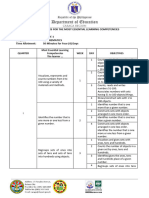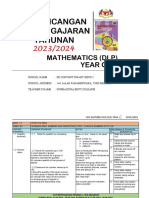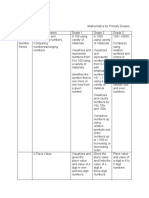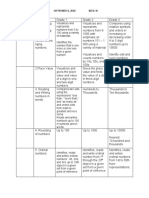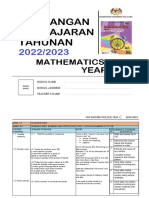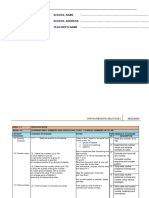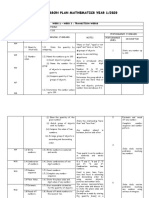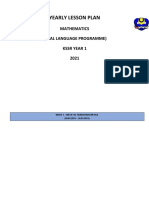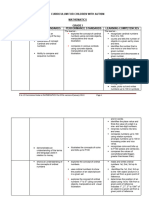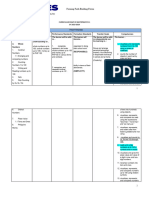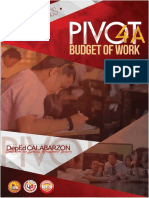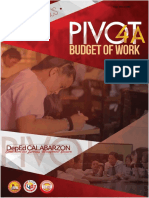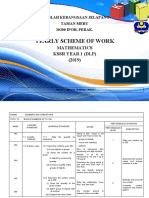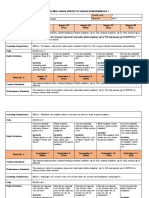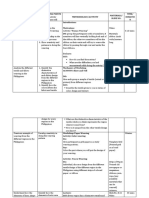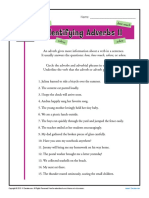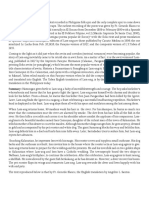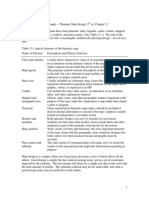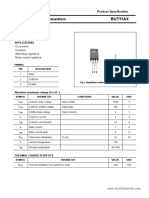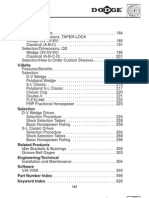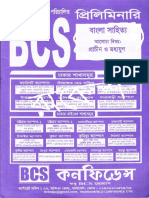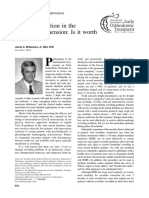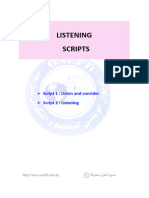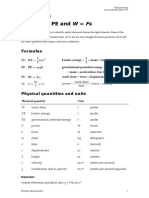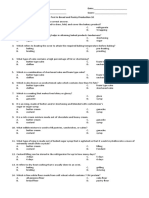0 ratings0% found this document useful (0 votes)
108 views60 pagesMathematics Grade 1-6
This document outlines the budget of works for essential learning competencies in Grade 1 Mathematics for the first two quarters. It includes 8 key competencies to be covered in 50 minute periods over 4 days each week. The competencies focus on developing foundational number sense including counting, comparing, ordering, addition, money recognition, and place value for numbers up to 100.
Uploaded by
La LayCopyright
© © All Rights Reserved
Available Formats
Download as DOCX, PDF, TXT or read online on Scribd
Download as docx, pdf, or txt
0 ratings0% found this document useful (0 votes)
108 views60 pagesMathematics Grade 1-6
This document outlines the budget of works for essential learning competencies in Grade 1 Mathematics for the first two quarters. It includes 8 key competencies to be covered in 50 minute periods over 4 days each week. The competencies focus on developing foundational number sense including counting, comparing, ordering, addition, money recognition, and place value for numbers up to 100.
Uploaded by
La LayCopyright
© © All Rights Reserved
Available Formats
Download as DOCX, PDF, TXT or read online on Scribd
Download as docx, pdf, or txt
Download as docx, pdf, or txt
You are on page 1/ 60
BUDGET OF WORKS FOR THE MOST ESSENTIAL LEARNING COMPETENCIES
Grade Level: GRADE 1
Subject: MATHEMATICS
Time Allotment: 50 Minutes for Four (4) Days
Most Essential Learning
QUARTER Competencies WEEK DAY OBJECTIVES
The learner …
1 Counts and tells the number of
objects in a given set.
Reads and writes numbers from 0
– 10 in symbols and in words.
2 Counts, reads and writes
Visualizes, represents and numbers 11-50.
counts numbers from 0 to Identifies numbers of sets having
1
100 using a variety of 11 to 50 objects.
materials and methods. 3 Counts, reads and writes
numbers 51-100.
Associates numbers with sets
having 51 to 100 objects/things.
4 Draws/construct sets with 1 to
100 objects.
1 Identifies number that is one
more than a given number.
2 Constructs sets with objects
I arranged in one more order.
Identifies the number that is 3 Identifies number that is one less
one more or one less from a 2 than a given number.
given number. 4 Constructs sets with objects
arranged in one less order.
Identifies the number that is one
more or one less from a given
number.
1 Visualizes and gives sets with
ones, tens and hundreds.
2 Counts the number of objects in a
Regroups sets of ones into given set by ones, tens and
sets of tens and sets of tens 3 hundreds.
into hundreds using objects. 3 Identifies/gives the ones, tens
and hundreds place of a given
number.
4 Regroups sets of ones into tens
and sets of tens.
1 Visualizes, represents and
compares two sets using
expressions “less than” and
“more than”.
Compares two sets using the Visualizes, represents and
expressions “less than,” 2 compares two sets using
“more than,” and “as many 4 expression “as many as”.
as” and orders sets from least Visualizes and represents sets
to greatest and vice versa. 3 from least to greatest and vice
versa.
Orders sets with 1 to 10 objects
4 from least to greatest and vice
versa.
Identifies number of sets with 1
1 to 25 objects.
Reads and writes numbers 1 to 25
in symbols and in words.
2 Identifies number of sets with 26
to 50 objects.
Reads and writes numbers up Reads and writes numbers 26 to
to 100 in symbols and in 50 in symbols and in words.
5
words. 3 Identifies number of sets with 51
to 75 objects.
Reads and writes numbers 51 to
75 in symbols and in words.
4 Identifies number of sets with 76
to 100 objects.
Reads and writes numbers 76 to
100 in symbols and in words.
Visualizes and gives the place 1 Visualizes and gives the place
value and value of a digit in value and value of a digit in one-
one- and two-digit numbers. and two-digit numbers.
2
Counts the number of objects in a
given set by ones and tens.
6
3 Renames numbers into tens and
Renames numbers into tens ones.
and ones. Identifies the place value of one-
to two-digit numbers.
Groups/draws sets of ones into
4 sets of tens.
Compares numbers up to 100 7 1 Visualizes, represents and
using relation symbol and compares numbers up to 100
orders them in increasing or using greater than, less than or
decreasing order. equal to.
2 Compare numbers up to 100
using relation symbols.
3 Visualizes and represents
numbers up to 100 in increasing
or decreasing order.
Orders numbers in increasing
4 order.
Orders numbers in decreasing
order.
1 Identifies, reads and writes
ordinal numbers: 1st, 2nd, 3rd, up
to 10th object in a given set from a
Identifies, reads and writes given point of reference.
ordinal numbers: 1st, 2nd, 2 Reads and writes ordinal
3rd, up to 10th object in a numbers: 1st, 2nd, 3rd up to 10th.
given set from a given point 8 3 Determine the position of the
of reference. objects.
Draw pictures of objects to
represent the ordinal numbers.
4 Constructs set with ordinal
numbers from a given point of
reference.
1 Identifies/recognizes the different
Philippine coins (in circulation).
Gives, reads and writes the value
Recognizes and compares of each coin
coins and bills up to PhP100 2 Identifies/recognizes Philippine
and their notations. 9 paper bills.
Gives, reads and writes the value
of each coin.
3
4 Compares coins and bills up to
PhP100.
Most Essential Learning
QUARTER Competencies WEEK DAY OBJECTIVES
The learner …
II Illustrates addition as 1 to 2 1 Illustrates addition as “putting
together or combining or joining
“putting together or
combining or joining sets”. sets.
2 Visualizes and adds two one-digit
numbers with sum up to 18 using
Visualizes and adds the the order zero properties of
following numbers using addition.
appropriate techniques: a. 3 Adds two one-digit numbers
two one-digit numbers with using appropriate mental
sums up to 18 b. three one- techniques.
Visualizes and adds three one-
4 digit numbers using the grouping
property of addition.
Visualizes and adds two to three
5 one-digit numbers horizontally
and vertically.
Adds mentally two to three one-
6 digit numbers with sums up to 18
using appropriate strategies.
digit numbers c. numbers Visualizes and adds numbers with
with sums through 99 7 sums through 99 without
without and with regrouping. regrouping.
Visualizes and adds numbers with
sums through 99 with regrouping.
8 Adds mentally two-digit numbers
and one-digit numbers with
regrouping using appropriate
strategies.
1 Analyses word problems involving
addition of whole umbers by
telling what is asked and what
is/are given in the problem.
Visualizes and solves one- Analyses word problems by
step routine and non-routine 2 telling the word clues and the
problems involving addition operation to be used.
of whole numbers including 3
money with sums up to 99 3 Transforms word problems into
using appropriate problem number sentences and gives the
solving strategies. correct answer.
4 Solves one-step word problems
involving addition of whole
numbers including money with
sums up to 99 without and with
regrouping using all the steps.
Illustrates subtraction as 4 Illustrates subtraction as “taking
“taking away” or “comparing” 1 away” or “comparing” elements
elements of sets. of sets.
Illustrates that addition and 2 Removes a subset from a given
subtraction are inverse set.
operations. Shows the relationship of removal
of a group of objects from a given
set to subtraction of whole
numbers.
3 Illustrates that addition and
subtraction are inverse
operations.
4 Analyses the illustration and
writes the number sentence and
the correct answer.
Visualizes, represents and
Visualizes, represents, and
1 subtracts one- digit numbers with
subtracts the following
minuends through 18 (basic
numbers: a. one-digit
facts).
numbers with minuends
2 Subtracts one- digit numbers with
through 18 (basic facts) b.
minuends through 18.
one- to two-digit numbers
5 to 6 3 Visualizes, represents and
with minuends up to 99
subtracts one- to two-digit
without regrouping c. one- to
numbers with minuends through
two-digit numbers with
99 without regrouping.
minuends up to 99 with
4 Subtracts one- to two-digit
regrouping.
numbers with minuends through
99 without regrouping.
5 Uses the expanded form to
explain subtraction with
regrouping.
6 Visualizes, represents and
subtracts one- to two-digit
numbers with minuends through
9 with regrouping.
7 Subtracts one- to two-digit
numbers with minuends through
99 with regrouping.
8 Determine the correct answer in
a subtraction sentence.
Evaluate the subtraction
sentence.
1 Subtracts mentally one-digit
numbers from minuends up to 18
without regrouping.
2 Matches number sentence with
the correct answer.
Answers subtraction problems in
Subtracts mentally one-digit 7 3 flash cards.
numbers from two-digit Evaluates subtraction sentences
minuends without regrouping presented.
using appropriate strategies. Subtracts mentally one-digit
4 numbers from two-digit
minuends without regrouping
using appropriate strategies.
Visualizes, represents, and Analyses word problems involving
solves routine and non- subtraction of whole numbers by
routine problems involving telling what is asked and what
subtraction of whole 1 is/are given in the problem.
numbers including money
with minuends up to 99 with
and without regrouping using 2 Analyses word problems by
appropriate problem solving telling the word clues and the
strategies and tools. operation to be used.
3 Transforms word problems into
number sentences and gives the
8 correct answer.
4 Solves word problems involving
subtraction of whole numbers
including money with minuends
up
to 99 without and with
regrouping using all the steps.
Most Essential Learning
QUARTER Competencies WEEK DAY OBJECTIVES
The learner …
III Counts groups of equal
Counts groups of equal quantity
quantity using concrete
using concrete objects up to 50.
objects up to 50 and writes 1
an equivalent expression. 2
e.g. 2 groups of 5. Writes the equivalent expression.
e.g. 2 groups of 5.
Visualizes, represents, and
separates objects into groups 1
3 Visualizes and represents objects
of equal quantity using into groups of equal quantity
concrete objects up to 50. using concrete objects up to 50.
e.g. 10 grouped by 5s. 4 Separates objects into groups of
equal quantity using concrete
objects up to 50. e.g. 10 grouped
by 5s.
2 1 Visualizes, represents and divides
a whole into halves.
Visualizes, represents, divides 2 Identifies ½ of a whole objects.
a whole into halves and 3 Visualizes, represents and divides
fourths and identifies ½ and ¼ a whole into fourths.
of a whole object. 4 Identifies ¼ of a whole objects.
Distinguishes ½ from ¼ of a
whole.
1 Visualizes, represents and divides
the elements of sets into two
Visualizes, represents and groups of equal quantities to
divides the elements of sets show halves.
into two groups of equal 2 Divides the elements of sets into
quantities to show halves and two groups of equal quantities to
four groups of equal show halves.
3
quantities to show fourths. 3 Visualizes, represents and divides
the elements of sets into four
groups of equal quantities to
show fourths.
4 Divides the elements of sets into
four groups of equal quantities to
show fourths.
1 Visualizes the whole region or set
given its ½.
Visualizes and draws the 2 Draws the whole region or set
whole region or set given its given its ½.
4
½ and/or ¼. 3 Visualizes the whole region or set
given its ¼.
4 Draws the whole region or set
given its ¼.
Identifies, names, and 1 Identifies the four basic shapes in
describes the four basic 2- and 3-dimensional objects.
shapes (square, rectangle, 2 Names the four basic shapes in 2-
triangle and circle) in and 3- dimensional objects.
2dimensional (flat/plane) and 3 Describes the four basic shapes in
3- dimensional (solid) objects 5
2- and 3-dimensional objects.
4 Compares the four basic shapes
in 2- and 3-dimensional objects.
Categorizes things according to
their shapes.
1 Draws the four basic shapes.
2 Compares/classifies two-
Draws the four basic shapes. dimensional shapes according to
common attributes.
Constructs three dimensional 6
objects (solid) using 3 Draws three dimensional objects.
manipulative materials
4 Constructs three dimensional
objects (solid) using manipulative
materials.
7 1 Identifies simple
continuous/repeating patterns.
2 Determines the missing term/s
Determines the missing using one attribute in a given
term/s using one attribute in continuous pattern (letters/
a given continuous pattern numbers/events).
(letters/ numbers/events) 3 Determines the missing term/s
and in a given repeating using one attribute in a given
pattern (letters, numbers, repeating pattern (letters,
colors, figures, sizes, etc.). numbers, colors, figures, sizes,
etc.).
4 Finds and completes patterns of
one attributes (letters, numbers,
colors, figures, sizes, etc.).
1 Identifies/Determines equivalent
Constructs equivalent number expression using addition
number expression using and subtraction.
addition and subtraction. e.g. 2 Constructs equivalent number
6 + 5 = 12 – 1. expression using addition and
subtraction.
8
Identifies and creates
patterns to compose and 3 Identifies the patterns to
decompose using addition. compose and decompose using
e.g. 7 = 0 + 7, 1 + 6, 2 + 5, 3 + addition.
4, 4 + 3, 5 + 2, 6 + 1, 7 + 0. Completes patterns to compose
4 and decompose using addition.
Creates patterns to compose and
decompose using addition.
Visualizes and finds the Visualizes and identifies the
missing number in an 1 missing number in an addition or
addition or subtraction subtraction sentence using a
sentence using a variety of variety of ways.
ways e.g. n + 2 = 5 5 – n = 3. 2 Determines the missing number
in an addition or subtraction
9 sentence using a variety of ways.
3 Finds the missing number in an
addition or subtraction sentence
using a variety of ways.
4 Completes the addition or
subtraction number sentence
using a variety of ways.
Most Essential Learning
QUARTER Competencies WEEK DAY OBJECTIVES
The learner …
IV 1 1 Tells and names the days in a
Tells the days in a week; week.
months in a year in the right 2 Identifies the names in a week.
order. 3 Tells and names the months in a
year.
4 Identifies the months in a year.
1 Uses a calendar to tell the day of
a given date.
Determines the day or the 2 Tells and locates the day of a
month using a calendar. given date.
2
3 Uses a calendar to tell the dates
of a given day.
4 Tells and locates the dates of a
given day.
1 Tells and writes time by hour.
Tells and writes time by hour, 2 Tells and writes time by half-hour.
half-hour and quarter hour 3 Tells and writes time by quarter
3
using analog clock. hour.
4 Identifies and indicates the time
shown on the clock.
1 Solves problems involving days in
a week.
2 Solves problems involving months
Solves problems involving in a year.
time (days in a week, months 4
3 Solves problems involving hour
in a year, hour, half-hour, and and half-hour.
quarter-hour). 4 Solves problems involving
quarter-hour.
1 Identifies short and long objects.
2 Compares objects using words:
short, shorter, shortest.
3 Compares objects using words:
Compares objects using long, longer, longest.
comparative words: short, 4 Identifies tall and high.
shorter, shortest; long,
5 to 6 5 Identifies light and heavy.
longer, longest; heavy,
heavier, heaviest; light, 6 Compares objects using words:
lighter, lightest. light, lighter, lightest.
7 Compares objects using words:
heavy, heavier, heaviest.
8 Solves problems involving
comparing objects.
Estimates and measures 7 1 Estimates and measures length
length, mass and capacity using non-standard units of linear
using non- standard units of measures.
measures. 2 Estimates and measures mass
using non-standard units of mass
measures.
3 Estimates and measures capacity
using non-standard units.
4 Solves problems involving non-
standard unit of measures.
1 Collects data on one variable
Infers and interprets data through simple interview.
presented in a pictograph 2 Sorts, classifies and organizes
without scales. e.g. finding data in tabular form.
out from the title what the 3 Presents data into a pictograph
pictograph is all about, 8 without scales.
comparing which has the 4 Infers and interprets data
least or greatest … presented in a pictograph without
scales.
Constructs pictograph based on a
given data.
1 Explains and interprets data
Solves routine and non- presented in a pictograph without
routine problems using data scales.
presented in pictograph 2 Illustrates data through a
without scales. pictograph.
9
3 Answers questions based on the
pictograph presented.
4 Solves routine and non-routine
problems using data presented in
pictograph without scales
References:
Most Essential Learning Competencies (MELC 2020)
DepEd Order No. 21, s. 2019
K to 12 Basic Education Curriculum
Grade Level: GRADE 2
Subject: MATHEMATICS
Time Allotment: 50 Minutes for Four (4) Days
Most Essential Learning
QUARTER Competencies WEEK DAY OBJECTIVES
The learner …
I Visualizes, represents and 1 1 Counts and tells the number of
counts numbers from 0 to 100 objects in a given set.
using a variety of materials and Reads and writes numbers from 0 –
methods. 10 in symbols and in words.
2 Counts, reads and writes numbers 11-
50.
Identifies numbers of sets having 11
to 50 objects.
3 Counts, reads and writes numbers 51-
100.
Associates numbers with sets having
51 to 100 objects/things.
4 Draws/construct sets with 1 to 100
objects.
1 Identifies number that is one more
than a given number.
2 Constructs sets with objects arranged
in one more order.
Identifies the number that is 3 Identifies number that is one less
one more or one less from a 2 than a given number.
given number. 4 Constructs sets with objects arranged
in one less order.
Identifies the number that is one
more or one less from a given
number.
1 Visualizes and gives sets with ones,
tens and hundreds.
2 Counts the number of objects in a
Regroups sets of ones into sets
given set by ones, tens and hundreds.
of tens and sets of tens into 3
3 Identifies/gives the ones, tens and
hundreds using objects.
hundreds place of a given number.
4 Regroups sets of ones into tens and
sets of tens.
Identifies, reads and writes
ordinal numbers from 1st 1
through the 20th object in a Reads ordinal numbers from 1st
given set from a given through the 20th object in a given set
point of reference. from a given point of reference.
4 Identifies ordinal numbers from 1st
2 through the 20th object in a given
Reads and writes money in set from a given point of reference.
symbols and in words Matches ordinal numbers from 1st
through PhP100. 3 through the 20th object in a given set
from a given point of reference.
Matches money in symbols and in
4 words through PhP100.
Counts the value of a set of Counts the value of a set of coins
bills or a set of coins through 1 through Php100 (centavo coins and
5 peso coins only).
PhP100 (peso-coins only;
centavo-coins only; peso-bills 2 Counts the value of a set of bills
through Php100 and a combination of
coins and bills.
only and combined peso-coins
3 Calculates and match the value of a
and peso-bills).
set of combined centavo- coins and
Compares values of different
peso bills through Php100.
denominations of coins and
4 Compares values of different
paper bills
denominations of coins and paper
through PhP100 using relation
bills through PhP100 using relation
symbols.
symbols.
Illustrates the properties of 1 Illustrates the commutative
addition (commutative, properties of addition.
associative, identity) and 2 Shows the associative properties of
applies each in appropriate addition.
and relevant situations. 3 Distinguishes the commutative,
6 associative and identity properties of
Visualizes, represents, and addition and applies each in
adds the following numbers appropriate and relevant situations.
with sums up to 1000 without Adds numbers 2-digit by 3-digit and
and with regrouping: 4 3-digit by 3-digit numbers with sums
a. 2-digit by 3-digit numbers up to 1000 with or without
b. 3-digit by 3-digit numbers regrouping.
1 Adds 1- to 2-digit numbers using
printed symbols with sum up to 50.
2 Adds 1- to 2-digit numbers with sum
Adds mentally the following
numbers using appropriate up to 50 in figure.
strategies: 3 Adds and match 1-to 2-digit numbers
a. 1- to 2-digit numbers with using printed symbols and figures.
sums up to 50 Adds 3-digit numbers and 1-digit
b. 3-digit numbers and 1-digit 4 numbers using printed symbols.
numbers
5 Adds 3-digit numbers and 1-digit
c. three -digit numbers and
7 to 8 numbers using figures.
tens (multiples of 10 up to
6 Adds and match 3-digit numbers and
90)
1-digit numbers using printed
d. 3-digit numbers and
symbols and in figures.
hundreds (multiples of 100 up
7 Adds three -digit numbers and tens
to 900)
(multiples of 10 up to 90 multiples of
100 up to 900) using real objects.
8 Solves three -digit numbers and tens
(multiples of 10 up to 90 and
multiples of 100 up to 900) vertically
and horizontally.
Solves routine and non-routine 1 Solves routine problems involving
problems involving addition of addition of whole numbers including
9
whole numbers including money with sums up 1 000 using
money with sums up to 1000 appropriate problem solving
strategies.
2 Creates routine problems involving
addition of whole numbers including
money with sums up 1 000 using
appropriate problem solving
strategies.
using appropriate problem
3 Solves non-routine problems
solving strategies and tools..
involving addition of whole numbers
including money with sums up 1 000
using appropriate problem solving
strategies.
4 Creates non-routine problems
involving addition of whole numbers
including money with sums up 1 000
using appropriate problem solving
strategies.
Most Essential Learning
QUARTER Competencies WEEK DAY OBJECTIVES
The learner …
1 Subtracts 2- to 3-digit numbers with
Visualizes, represents, and minuends up to 999 without
subtracts 2- to 3-digit numbers regroupings.
with minuends up to 999 2 Diminishes 2- to 3-digit numbers with
without and with regrouping. minuends up to 999 with
regroupings.
1
Visualize 2- to 3-digit numbers with
3 minuends up to 999 with or without
regroupings.
Subtracts 2- to 3-digit numbers with
II 4 minuends up to 999 with or without
regrouping.
1 Subtracts 1-digit numbers from 1-to
Subtracts mentally the 3-digit numbers without regrouping.
following numbers without Diminishes 1-digit numbers from 1-to
regrouping using appropriate 2 3-digit numbers with regrouping.
strategies:
2 Subtracts 3-digit number by tens
a. 1-digit numbers from 1- to 3- 3 without regrouping.
digit numbers
b. 3-digit numbers by tens and 4 Calculates by subtracting 3-digit
by hundreds number by tens and hundreds
without regroupings.
Solves routine and non-routine Solves routine problems involving
problems involving subtraction 1 subtraction of whole numbers
of whole numbers including including money with minuends up to
3 1000 using appropriate problem
money with
minuends up to 1000 using solving strategies and tools.
appropriate problem solving 2 Creates routine problems involving
subtraction of whole numbers
including money with minuends up to
1000 using appropriate problem
solving strategies and tools.
3 Solves non-routine problems
involving subtraction of whole
numbers including money with
minuends up to 1000 using
strategies and tools. appropriate problem solving
strategies and tools.
4 Creates non-routine problems
involving subtraction of whole
numbers including money with
minuends up to 1000 using
appropriate problem solving
strategies and tools.
Illustrates order of operations
1 involving addition and subtractions of
small numbers.
2 Identifies order of operations
involving addition and subtractions of
Performs orders of operations
small numbers.
involving addition and 4
3 Simplifies order of operations
subtractions of small numbers.
involving addition and subtractions of
small numbers.
4 Constructs order of operations
involving addition and subtraction of
small numbers.
5 1 Solves multi-step routine problems
Solves multi-step routine and involving addition and subtraction of
non-routine problems involving 2- to 3-digit numbers including
addition and subtraction of 2- money using appropriate problem
to 3-digit numbers including solving strategies and tools.
money using appropriate 2 Solves multi-step non-routine
problem solving strategies and problems involving addition and
tools. subtraction of 2- to 3-digit numbers
including money using appropriate
problem solving strategies and
tools.through 9 with regrouping.
3 Solves multi-step routine and non-
routine problems involving
subtraction of 2- to 3-digit numbers
including money using appropriate
problem solving strategies and tools.
4 Creates routine or non- routine
problems involving addition and
subtraction of 2- to 3-digit numbers
including money using appropriate
problem solving strategies and tools..
Illustrates and writes a related 1 Illustrates multiplication as repeated
equation for each type of addition.
multiplication: repeated 2 Illustrates multiplication as array and
addition, array, counting by counting by multiples.
multiples, and equal jumps on Demonstrates multiplication as
the number line. 3 repeated addition using equal jumps
of the number line.
6
Illustrates and writes a related
Writes a related equation for each
equation for each type of 4
type of multiplication: repeated
multiplication: repeated
addition, array, counting by multiples,
addition, array, counting by
and equal jumps on the number line.
multiples, and equal jumps on
the number line.
Illustrates the property of
Illustrates the following 1 multiplication that any number
properties of multiplication and multiplied by one is the number.
apply each in relevant 2 Illustrates the property of
situation: (a) identity, (b) zero, multiplication that zero multiplied by
and, (c) commutative. 7 any number is zero.
3 Distinguishes the commutative
property of multiplication.
4 Solves the following properties of
multiplication and apply each in
relevant situation.
Visualizes multiplication of 1 Illustrates multiplication of numbers
numbers 1 to 10 by 2,3,4,5 1 to 10 by 2,3,4,5.
and10. 2
Illustrates multiplication of numbers
Multiplies mentally 2,3,4,5 and 1 to 10 by 6,7,8,9 and 10.
10 using appropriate 8 3 Expresses multiplication facts for
strategies. numbers 1 through 5 and and 6
through 10 using appropriate
strategies.
4 Solves by multiplying mentally 2,3,4,5
and 10 using appropriate strategies.
9 Explains routine problems using
Solves routine and non-routine 1 appropriate problem solving
problems using appropriate strategies and tools: multiplication of
problem solving strategies and whole numbers including money.
tools: Illustrates non-routine problems
a. multiplication of whole 2 using appropriate problem solving
numbers strategies and tools multiplication of
including money whole numbers including money.
b. multiplication and addition 3 Identifies routine and non-routine
or subtraction of whole problems using appropriate problem
numbers including money solving strategies and tools:
multiplication and addition or
subtraction of whole numbers
including money.
4 Analyses and solve routine and non-
routine problems using appropriate
problem solving strategies and tools:
a. multiplication of whole numbers
including money
b. multiplication and addition or
subtraction of whole numbers
including money.
Most Essential Learning
QUARTER Competencies WEEK DAY OBJECTIVES
The learner …
III Visualizes division of related equation
Visualizes and represents 1 for equal sharing.
division, and writes a related 2 Demonstrates division of related
equation for each type of equation in a situation with repeated
situation: equal sharing, subtraction.
repeated subtraction, equal 3 Shows division of related equation in
jumps on the number line, and a situation using equal jumps on the
formation of equal groups of 1
number line and formation of equal
objects. groups of objects.
4 Writes a related equation for each
type of situation: equal sharing,
repeated subtraction, equal jumps on
the number line, and formation of
equal groups of objects.
1 Expresses division facts of numbers
up to 100 by 2,3,4,5.
2 Expresses division facts of numbers
Visualizes division of numbers up to 100 by 6,7,8,9 and 10.
up to 100 by 2,3,4,5, and 10 3 Expresses multiplication facts of
2
(multiplication table of 2, 3, 4, numbers up to 100 by 2,3,4,5 and by
5 and 10). 6,7,8,9 and 10.
4 Solves division of numbers up to 100
by 2,3,4,5, and 10 (multiplication
table of 2, 3, 4, 5 and 10).
3 1 Demonstrates in dividing mentally
numbers by 2,3,4,5 using appropriate
Divides mentally numbers by strategies (multiplication table of 2,
2,3,4,5 and 10 using 3,)
appropriate strategies 2 Calculates by dividing mentally
(multiplication table of 2, 3, 4, numbers by 2,3,4,5 using appropriate
5 and 10). strategies (multiplication table of 4, 5
and 10)
3 Illustrates that multiplication and
Illustrates that multiplication division are inverse operations.
and division are inverse 4 Justifies that multiplication and
operations. division are inverse operations.
Solves routine and non-routine Explains routine problems involving
problems involving division of division of numbers by 2,3,4,5, and 10
numbers by 2,3,4,5 and 10 and 1 and with any of the other operations
with any of the other of whole numbers including money
operations of whole numbers using appropriate problem solving
including money using strategies and tools.
appropriate problem solving Illustrates non-routine problems
strategies and tools. 2 involving division of numbers by
2,3,4,5, and 10 and with any of the
other operations of whole numbers
including money using appropriate
problem solving strategies and tools.
4 3 Identifies routine and non-routine
problems involving division of
numbers by 2,3,4,5 and 10 and with
any of the other operations of whole
numbers including money using
appropriate problem solving
strategies and tools.
Creates routine and non-routine
problems involving division of
4 numbers by 2,3,4,5 and 10 and with
any of the other operations of whole
numbers including money using
appropriate problem solving
strategies and tools.
Visualizes, represents and 1 Identifies unit fractions with
identifies unit fractions with denominators of 10 and below.
denominators of 10 and below. 2 denominators 10 and below. Reads
unit fractions and write unit fractions.
Reads and writes unit fractions.
5 to 6 3 Compares using relation symbols in
Compares using relation increasing order the unit fractions.
symbol and arranges in 4 Compares using relation symbols in
increasing or decreasing order decreasing order the unit fractions.
the unit fractions. 5 Arranges using relation symbols in
Identifies other fractions less increasing or decreasing order the
than one with denominators 10 unit fractions.
and below. 6 Identifies other fractions less than
one denominators 10 and below.
Visualizes (using group of
objects and number line), reads 7 Reads similar fractions using group of
and writes similar fractions. objects and number line.
8 Writes similar fractions using group of
objects and number line.
1 Identifies similar fractions using
Compares similar fractions relation symbols.
using relation symbols. 2 Compares similar fractions using
relation symbols.
Arranges similar fractions in 7 3 Orders similar fractions in increasing
increasing or decreasing order. order.
4 Compares and arrange similar
fractions in increasing or decreasing
order.
Constructs squares, rectangles, 1 Matches squares, rectangles,
triangles, circles, half circles, triangles, circles, half circles, and
and quarter circles using cut- quarter circles using cut-outs and
outs and square grids. square grids.
2 Classifies squares, rectangles,
triangles, circles, half circles, and
Identifies straight lines and
quarter circles using cut-outs and
curves, flat and curved surfaces
8 square grids.
in a 3-dimensional object.
3 Constructs squares, rectangles,
triangles, circles, half circles, and
quarter circles using cut-outs and
square grids.
4 Identifies straight lines and curves,
flat and curved surfaces in a 3-
dimensional object.
9 Determines the missing term/s in a
1 given continuous pattern using two
attributes (any two of the following:
figures, numbers, colors, sizes and
orientations, etc. ) e.g.1, A,2, B, 3, C,
__,___
Determines the missing term/s 2 Chooses the missing term/s in a given
in a given continuous pattern continuous pattern using two
using two attributes (any two attributes (any two of the following:
of the following: figures, figures, numbers, colors, sizes and
numbers, colors, sizes,and orientations, etc. ) e.g. 1, A, 2, B, 3, C,
orientations, etc.) e.g. 1, A, __,___
2,B,3,C,__,__ 3 Finds the missing term/s in a given
continuous pattern using two
attributes (any two of the following:
figures, numbers, colors, sizes and
orientations, etc. ) e.g. 1, A, 2, B, 3, C,
__,___
Write the missing term/s in a given
4 continuous pattern using two
attributes (any two of the following:
figures, numbers, colors, sizes and
orientations, etc. ) e.g. 1, A, 2, B, 3, C,
__,___
Most Essential Learning
QUARTER Competencies WEEK DAY OBJECTIVES
The learner …
IV 1 Tells time in minutes including a.m.
Tells and writes time in and p.m. using analog and digital
minutes including a.m. and clock..
p.m. using analog and digital 2 Writes time in minutes including a.m.
clocks. and p.m. using analog and digital
clock.
1
3 Solve problems involving time
(minutes including a.m. and p.m. and
elapsed time in days).
4 Creates problems involving time
(minutes including a.m. and p.m. and
elapsed time in days).
1 Identifies the unit of measure in
Compares the following unit of length in meter or centimetre.
measures: 2 Identifies the unit of measure in mass
a. length in meters or in grams or kilograms.
centimeters 3 Determines the unit of measure in
b. mass in grams or kilograms capacity in mL or L.
2
c. capacity in mL or L 4 Compares of the following unit of
measures:
a. length in meters or
centimeters
b. mass in grams or kilograms
c. capacity in mL or L
3 1 Identifies objects using appropriate
Measures objects using measuring tools and unit of length in
appropriate measuring tools m or cm.
and unit of length in m or cm. 2 Make use of objects using
appropriate measuring tools and unit
of length in m or cm.
3 Measures objects using appropriate
Estimates and measures length measuring tools and unit of length in
using meter or centimeter. m or cm.
4 Estimates length using meter o
centimeter.
1 Explains routine problems involving
length.
Solves routine and non-routine 2 Illustrates non-routine problems
problems involving length. involving length.
4
3 Identifies routine and non- routine
problems involving length.
4 Solves routine and non-routine
problems involving length.
1 Identifies objects using appropriate
Measures objects using measuring tools and measuring units
appropriate measuring tools in g or kg.
and measuring units in g or kg. 2 Make use of objects using
appropriate measuring tools and
5 measuring units in g or kg.
3 Estimates mass using gram or
Estimates and measures mass kilogram.
using gram or kilogram. 4 Measures objects using appropriate
measuring tools in g or kg.
1 Illustrates routine and non-routine
Solves routine and non-routine problems involving mass.
problems involving mass. 2 Solves routine and non-routine
problems involving mass.
6
Measures objects using 3 Creates routine and non-routine
appropriate measuring tools in problems involving mass.
mL or L. 4 Identifies and measures objects using
appropriate tools in mL or L.
Finds the area of a given figure 1 Finds the area of a given figure using
using square-tile units i.e. square-tile units i.e. number of
number of square-tiles needed. square-tiles needed.
2 Measures the area of a given figure
7 using square-tile units.
Estimates the area of a given 3 Determines the area of a given figure
figure using any shape. using square-tile units
4 Estimates the area of a given figure
using any shape.
1 Illustrates routine problems involving
Solves routine and non-routine any figure using square tiles.
problems involving any figure 2 Explains non-routine problems
using square tiles. involving any figure using square tiles.
8 3 Solves routine and non-routine
problems involving any figure using
square tiles.
4 Creates routine and non-routine
problems involving any figure using
square tiles.
Infers and interprets data 1 Infers data presented in a pictograph
presented in a pictograph with and without scales.
without and with scales. 2 Interprets data presented in a
pictograph with and without scales.
Solves routine and non-routine
problems using data presented 9 3 Solves routine and non-routine
in a pictograph without and problems using data presented in a
with scales. pictograph without and with scales.
4 Creates routine and non-routine
problems using data presented in a
pictograph without and with scales.
References:
Most Essential Learning Competencies (MELC 2020)
DepEd Order No. 21, s. 2019
K to 12 Basic Education Curriculum
Grade Level: GRADE 3
Subject: MATHEMATICS
Time Allotment: 50 Minutes for Four (4) Days
Most Essential Learning
QUARTER Competencies WEEK DAY OBJECTIVES
The learner …
I Visualizes numbers up to 10,000 1 Illustrates numbers 1,001 up to
with emphasis on numbers 1,001 - 10,000.
10,000. 2 Identifies the place value and value of
a digit in a number up to 10,000.
Gives the place value and value of 1 3 Reads numbers through 10,000 in
a digit in 4- to 5-digit numbers. symbols and in words.
4
Writes numbers through 10,000 in
Reads and write numbers up to
symbols and in words.
10,000 in symbols and in words.
1 Rounds off numbers to the nearest
Rounds numbers to the nearest
tens and hundreds.
ten, hundred and thousand.
2 Rounds off numbers to the nearest
thousands.
Compares using relation symbols 2
3 Compares numbers up to 10,000 using
and orders in increasing or
relation symbols.
decreasing order 4- to 5-digit
4 Orders numbers up to 10,000 in
numbers to 10,000.
increasing or decreasing order.
Identifies ordinal numbers from 3 1 Identifies ordinal numbers from 1st to
1st to 100th with emphasis on the 100th with the emphasis on the 21st
21st to 100th object in a given set to 100th object in a given set from a
given point of reference.
2 Distinguishes coins and bills up to Php
from a given point of reference.
1,000.
3 Reads money in symbols and in words
Recognizes, reads and writes
through Php 1,000 in pesos and
money in symbols and in words
centavos.
through Php 1,000 in pesos and
4 Writes money in symbols and in words
centavos.
through Php 1,000 in pesos and
centavos.
1 Compares values of the different
denominations of coins and bills
through Php 500 using relation
Compares values of the different
symbols.
denominations of coins and bills
2 Compares values of the different
through Php 1,000 using relation
denominations of coins and bills
symbols.
through Php 1,000 using relation
4
symbols.
Adds 3- to 4-digit numbers up to
3 Computes by adding 3- to 4-digit
three addends with the sum up to
numbers up to three addends with the
10,000 without and with
sum up to 10,000 without regrouping.
regrouping.
4 Computes by adding 3- to 4-digit
numbers up to three addends with the
sum up to 10,000 with regrouping.
1 Estimates the sum of 3- to 4-digit
Estimates the sum of 3- to 4-digit
addends using appropriate strategies.
addends with reasonable results.
2 Computes by adding mentally 1- to 2-
digit numbers without regrouping
Adds mentally the following
using appropriate strategies.
numbers using appropriate
5 3 Computes by adding mentally 1- to 2-
strategies:
digit numbers with regrouping using
a. 2-digit and 1-digit numbers
appropriate strategies.
without or with regrouping
4 Computes by adding mentally 2- to 3-
b. 2-to 3-digit numbers with
digit numbers with multiples of
multiples of hundreds.
hundreds using appropriate strategies.
Solves routine and non-routine 6 1 Solves routine problems involving
problems involving addition of addition of whole numbers with sums
whole numbers with the sum up of 10,000 including money using
to 10,000 including money using appropriate problem solving strategies
appropriate problem solving and tools.
strategies and tools. 2 Creates routine problems involving
addition of whole numbers with sums
of 10,000 including money using
appropriate problem solving strategies
and tools.
3 Solves non-routine problems involving
addition of whole numbers with sums
of 10,000 including money using
appropriate problem solving strategies
and tools.
4 Creates non-routine problems
involving addition of whole numbers
with with sums of 10,000 including
money using appropriate problem
solving strategies and tools.
1 Calculates by subtracting 3- to 4-digit
numbers from 3- to 4-digit numbers
without regrouping.
Subtracts 3- to 4-digit numbers
2 Calculates by subtracting 3- to 4-digit
from 3- to 4-digit numbers without
numbers from 3- to 4-digit numbers
and with regrouping.
with regrouping.
7
3 Calculates by subtracting 4-digit
Estimates the difference of two
numbers from 3- to 4-digit numbers
numbers with three to four digits
with regrouping.
with reasonable results.
4 Estimates the difference of two
numbers with 3- to 4-digit with
reasonable results.
1 Computes by subtracting mentally 1-
to 2-digit numbers without
Subtracts mentally the following
regrouping.
numbers using appropriate
2 Computes by subtracting mentally 1-
strategies.
to 2-digit numbers with regrouping.
a. 1- to 2-digit numbers without
8 3 Computes by subtracting mentally 2-
and with regrouping
to 3-digit numbers with multiples of
b. 2- to 3-digit numbers with
hundreds without regrouping.
multiples of hundreds without and
4 Computes by subtracting mentally 2-
with regrouping.
to 3-digit numbers with multiples of
hundreds with regrouping.
1 Solves routine problems involving
subtraction of whole numbers
including money.
2 Solves non-routine problems involving
Solves routine and non-routine
subtraction of whole numbers
problems involving subtraction
including money.
without or with addition of whole
9 3 Solves two-step problems involving
numbers including money using
addition and subtraction of whole
appropriate problem solving
numbers including money.
strategies and tools.
4 Creates problems involving addition or
subtraction of whole numbers
including money with reasonable
answers.
QUARTER Most Essential Learning WEEK OBJECTIVES
Competencies DAY
The learner …
1 Illustrates the multiplication of the
Visualizes multiplication of numbers 6 and 7.
numbers 1 to 10 by 6, 7, 8 and 9. 2 Illustrates the multiplication of the
numbers 8 and 9.
1
Visualizes and states basic 3 Expresses multiplication facts for
multiplication facts for numbers numbers 1 through 5.
up to 10. 4 Expresses multiplication facts for
numbers 5 through 10.
Illustrates the properties of 1 Applies the commutative property of
multiplication in relevant Multiplication.
situations (commutative 2 Applies the distributive property of
property, distributive property, multiplication in multiplying 2-digit
or associative property) numbers by 1-digit numbers.
multiplies numbers: 3 Applies the associative property of
a. 2- to 3-digit numbers by 1-digit multiplication in multiplying 3-digit
II numbers without or with numbers by 1-digit numbers.
regrouping. 4 Computes by multiplying 2- to 3-digit
b. 2-digit numbers by 2-digit numbers by 1-digit numbers without
numbers without regrouping. or with regrouping.
c. 2-digit numbers by 2-digit 2&3 5 Computes by multiplying 2-digit
numbers with regrouping. numbers by 2-digit numbers without
d. 2- to 3-digit numbers by regrouping.
multiples of 10 and 100. 6 Calculates by multiplying 2-digit
e. 1- to 2-digit numbers by 1,000. numbers by 2-digit numbers with
regrouping.
7 Calculates by multiplying 2- to 3-digit
numbers by multiples of 10 and 100.
8
Calculates by multiplying 1- to 2-digit
numbers by 1,000.
1 Estimates the product of 2-digit
numbers and 1- to 2-digit numbers
Estimates the product of 2-to 3- with reasonable results.
digit numbers and 1-to 2-digit 2 Estimates the product of 3-digit
number with reasonable results. numbers and 1- to 2-digit numbers
with reasonable results.
Multiplies mentally 2-digit by 1 4 3 Determines the highest and lowest
digit numbers without possible number/s that would equate
regrouping with products of up the given estimated product.
to 100. 4 Computes by multiplying mentally 2-
digit numbers by 1-digit numbers
without regrouping with products of
up to 100.
Solve routine and non-routine 5 1 Solves routine problems involving
multiplication of whole numbers
including money using appropriate
problem solving strategies and tools.
2 Solves non-routine problems involving
multiplication of whole numbers
including money using appropriate
problems involving multiplication problem solving strategies and tools.
without or with additional 3 Solves routine and non-routine
subtraction of whole numbers problems involving multiplication with
including money using appropriate additional subtraction of whole
problem solving strategies and numbers including money using
tools. appropriate problem solving strategies
and tools.
4 Creates problems involving
multiplication without or with addition
or subtraction of whole numbers
including money with reasonable
answers.
Visualizes and state the multiples 1 Expresses the multiples of 1- to 2-digit
of 1- to 2-digit numbers. numbers.
2 Illustrates division of numbers up to
Visualizes division of numbers up 100 by 6 and 7.
6
to 100 by 6, 7, 8 and 9. 3 Illustrates division of numbers up to
(multiplication table of 6, 7, 8, and 100 by 8.
9). 4 Illustrates division of numbers up to
100 by 9.
Visualizes and states basic division 1 Expresses division facts of numbers up
facts of numbers up to 10. to 10.
2 Calculates by dividing 2- to 3-digit
Divides numbers without or with numbers by 2-digit without and with
remainder: 7 remainder.
a. 2- to 3-digit numbers by 2-digit 3 Calculates by dividing 2-digit numbers
numbers by 10 and 100.
b. 2- to 3-digit numbers by 10 and 4 Calculates by dividing 3-digit numbers
100. by 10 and 100.
Estimate the quotient of 2- to 3- 8 1 Estimates the quotient of 2- to 3-digit
digit numbers by 1- to 2-digit numbers by 1-digit numbers with
numbers. reasonable results.
2 Estimates the quotient of 2- to 3-digit
Divides mentally 2-digit numbers numbers by 2-digit numbers with
by 1-digit number without reasonable results.
remainder using appropriate 3 Determines the highest and lowest
strategies. possible number/s that would equate
the given estimated quotient.
4 Computes by dividing mentally 2-digit
numbers by 1-digit numbers without
remainder using family fact/basic
division fact, cross-out method,
renaming and compensation method.
Solves routine and non-routine 1 Solves routine problem involving
problem involving division of 2- to division of 2- to 4-digit numbers by 1-
4-digit numbers by 1- to 2-digit to 2-digit numbers without or with any
numbers without or with any of other operations of whole number
the other operations of whole including money using appropriate
numbers including money using problem solving strategies and tools.
appropriate problem solving 2 Creates routine problem involving
strategies and tools. division of 2- to 4-digit numbers by 1-
to 2-digit numbers without or with any
other operations of whole number
including money using appropriate
problem solving strategies and tools.
9
3 Solves non-routine problem involving
division of 2- to 4-digit numbers by 1-
to 2-digit numbers without or with any
other operations of whole number
including money using appropriate
problem solving strategies and tools.
4 Creates non-routine problem involving
division of 2- to 4-digit numbers by 1-
to 2-digit numbers without or with any
other operations of whole number
including money using appropriate
problem solving strategies and tools.
Most Essential Learning DAY
QUARTER Competencies WEEK OBJECTIVES
The learner …
Identify odd and even numbers. 1 Identifies odd and even numbers.
2 Determines the greatest and lowest
Visualizes and represents fractions odd and even numbers out from the
that are equal to one and greater given 3- to 4-digit numbers.
than one in symbols and in words. 3 Computes by adding or subtracting
III 1 the greatest and lowest odd and even
numbers out from the given 3- to 4-
digit numbers.
4 Illustrates fractions that are equal to
one and greater than one in symbols
and in words.
Reads and writes fractions that are 2 1 Reads fractions that are greater than
equal to one and greater than one one in symbols and in words.
in symbols and in words. 2 Reads fractions that are less than one
in symbols and in words.
3 Writes fractions that are greater than
one in symbols and in words.
4 Writes fractions that are less than one
in symbols and in words.
Represent, compares and arranges 1 Expresses fractions using regions, sets,
dissimilar fractions in increasing or and number lines.
decreasing order. 2 Illustrates dissimilar fractions.
3 3 Compares sdissimilar fractions using
symbol of relations.
4 Arranges dissimilar fractions in
increasing or decreasing order.
Visualizes and generates 1 Illustrates equivalent fractions using
equivalent fractions. circles.
2 Illustrates equivalent fractions using
blocks.
4 3 Distinguishes whether the given set of
fractions are equivalent fractions or
not.
4 Creates at least three equivalent
fractions.
Recognizes and draws a point, line, 1 Illustrates a point, line, line segment
line segment and ray. and ray.
2 Compares a point, line, line segment
Recognizes and draws parallel, and ray.
5
intersecting and perpendicular 3 Illustrates parallel, intersecting and
lines. perpendicular lines.
4 Compares parallel, intersecting and
perpendicular lines.
Visualizes, identifies and draws 1 Illustrates congruent line segments.
congruent line segments. 2 Compares congruent line segments.
3 Examines symmetry in the
Identifies and visualizes symmetry 6 environment and in design.
in the environment and in design. 4 Distinguishes whether an object is
symmetrical or non symmetrical in the
environment and in design.
Identifies and draws the line of 1 Identifies line of symmetry in a given
symmetry in a given symmetrical symmetrical figure.
figure. 2 Draws line of symmetry in a given
symmetrical figure.
7
Completes a symmetric figure with 3 Completes a symmetric figure with
respect to a given line of respect to a given line of symmetry.
symmetry. 4 Tesselates the plane using triangles,
squares and other shapes.
Determines the missing term/s 8 1 Determines the missing term/s in a
in a given combination of given combination of continuos and
continuous and repeating repeating pattern involving shapes
pattern. patterns.
e.g. 4A, 5B, 6A, 7B, _______ 2 Determines the missing term/s in a
given combination of continuos and
repeating pattern involving figures and
alphabets patterns.
3 Determines the missing term/s in a
given combination of continuos and
repeating pattern involving numeric
patterns.
4 Determines the missing term/s in a
given combination of continuos and
repeating pattern involving apha-
numeric patterns.
Finds the missing value in a 1 Finds the missing value in a number
number sentence involving sentence involving multiplication of
multiplication or division of whole numbers with 1- to 2-digits
whole numbers. factors.
e.g. n x 7 = 56 56 / n = 8 2 Finds the missing value in a number
sentence involving multiplication of
whole numbers with 2- to 3-digit
factors.
9
3 Finds the missing value in a number
sentence involving division of whole
numbers with 1- to 2-digits dividend
and 1-digits divisors.
4 Finds the missing value in a number
sentence involving division of whole
numbers 1- to 3-digits dividend and 1-
digits divisors.
Most Essential Learning DAY
QUARTER Competencies WEEK OBJECTIVES
The learner …
Visualizes, represents and 1 Converts time measure from seconds
converts time measure: to minutes, minutes to hours, and
a. from seconds to minutes, hours to a day and vice versa.
minutes to hours, and hours to 2 Converts time measure from days to
a day and vice-versa. weeks, months and years and vice
IV 1
b. days to week, month and year versa.
and vice-versa. 3 Converts time measure from weeks to
c. weeks to months and year and months and years and vice versa.
vice-versa. 4 Converts time measure from months
d. months to year and vice-versa. to years and vice versa.
Solves problems involving 2 1 Solves problems involving conversion
conversion of time measure. of time measure from seconds to
minutes, minutes to hours, and hours
to a day and vice versa.
2 Solves problems involving conversion
of time measure from days to weeks,
months and years and vice versa.
3 Solves problems involving conversion
of time measure from weeks to
months and years and vice versa.
4 Solves problems involving conversion
of time measure from months to years
and vice versa.
Visualizes, and represents and 1 Converts common units of linear
converts common units of measure from larger unit to smaller
measure from larger to smaller unit and vice versa: meter (m) and
unit and vice-versa: meter and centimeter (cm).
centimetre, kilogram and gram, 2 Converts common unit of measure
liter and millilitre. from larger unit to smaller unit and
3 vice versa: kilogram (kg) to gram (g).
Visualizes, and represents, and 3 Converts common unit of measure
solves routine and non-routine from larger unit to smaller unit and
problems involving conversions of vice versa: liter (L) to milliliter (mL).
common units of measure. 4 Solves routine and non-routine
problems involving conversions of
common units of measure.
Solves routine and non-routine 1 Solves routine problems involving
problems involving capacity capacity measure.
measure. 2 Creates routine problems involving
capacity measure.
4
3 Solves routine problems involving
capacity measure.
4 Creates non-routine problems
involving capacity measure.
. Visualizes, and represents and 1 Measures area using appropriate
measures area using appropriate units.
unit. 2 Finds the area of a rectangle in square
centimeter and square meter.
Solves routine and non-routine 5 3 Finds the area of a square in square
problems involving areas of centimeter and square meter.
squares and rectangles. 4 Solves routine and non-routine
problems involving areas of squares
and rectangles.
Collects data on one variable using 1 Collects data on one variable using
existing records. existing records.
2 Organizes data in tabular form and
Sorts, classifies, and organizes present this into a vertical bar graph.
6
data in tabular form and presents 3 Organizes data in tabular form and
this into a vertical or horizontal present this into horizontal bar graph.
bar graph. 4 Creates vertical or horizontal bar
graph base on the data given.
Infers and interprets data 1 Interprets data presented in vertical
presented in different kinds of bar bar graph.
graphs (vertical/horizontal). 2 Draws inferences based on data
presented in vertical bar graph.
7
3 Interprets data presented in
horizontal bar graph.
4 Draws inferences based on data
presented in horizontal bar graph.
Solves routine and non-routine 1 Solves routine problems using data
problems using data presented in presented in a single-bar graph.
a single-bar graph. 2 Creates routine problems using data
presented in a single-bar graph.
8
3 Solves non-routine problems using
data presented in a single-bar graph.
4 Creates routine problems using data
presented in a single-bar graph.
Tells whether an event is sure, 1 States whether an event is sure, likely,
likely, equally likely, unlikely, and equally likely, unlikely, and impossible
impossible to happen. to happen.
9
2 Writes possible events whether an
Describes events in real-life event is sure, likely, equally likely,
situations using the phrases “sure unlikely, and impossible to happen.
to happen”, “likely to happen”, 3 Describes events in real-life situations
using the phrases “sure to happen”,
“likely to happen”, “equally likely to
happen”, “unlikely to happen”, and
“impossible to happen”.
4 Writes possible events in real-life
situations using the phrases “sure to
happen”, “likely to happen”, “equally
likely to happen”, “unlikely to
happen”, and “impossible to happen”.
References:
Most Essential Learning Competencies (MELC 2020)
DepEd Order No. 21, s. 2019
K to 12 Basic Education Curriculum
Grade Level: GRADE 4
Subject: MATHEMATICS
Time Allotment: 50 Minutes for Four (4) Days
Most Essential Learning
QUARTER Competencies WEEK DAY OBJECTIVES
The learner …
Visualizes numbers up to 100 000 1 Visualizes numbers up to 100 000 with
with emphasis on numbers 10 emphasis on numbers 10 001–50 000.
001–100 000. 2 Visualizes numbers up to 100 000 with
emphasis on numbers 50 001–100
Gives the place value and value of 000.
a digit in numbers up to 100 000. 3 Gives the place value and value of a
I 1
digit in numbers up to 100 000.
Reads and writes numbers, in 4
Reads and writes numbers, in symbols
symbols and in words, up to
and in words, up to hundred thousand
hundred thousand and compare
and compare them using relation
them using relation symbols.
symbols.
1 Rounds numbers to the nearest
thousand and ten thousand.
Rounds numbers to the nearest
2 Compares numbers up to 100 000
thousand and ten thousand.
using relational symbols.
2 3 orders numbers up to 100 000 in
Orders numbers up to 100 000 in
increasing or decreasing order.
increasing or decreasing order.
4 Solves word problem involving
rounding numbers to the nearest
thousand and ten thousand.
1 Multiplies numbers up to 3-digit
Multiplies numbers up to 3-digit numbers by up to 2-digit numbers
numbers by up to 2-digit numbers without regrouping.
without or with regrouping. 2 Multiplies numbers up to 3-digit
numbers by up to 2-digit numbers
Estimates the products of 3- to 4- 3 with regrouping.
digit numbers by 2- to 3- digit 3 Estimates the products of 3- to 4-digit
numbers with reasonable numbers by 2- to 3- digit numbers
results. with reasonable results.
4 Solves word problems involving
multiplication of whole numbers.
Multiplies mentally 2-digit by 1-to 4 1 Multiplies mentally 2-digit by 1-digit
2-digit numbers with products up numbers with products up to 200 and
to 200 and explains the strategies explains the strategies used.
used. 2 Multiplies mentally 2-digit by 2-digit
numbers with products up to 200 and
Solves routine and non-routine explain the strategies used.
problems involving multiplication 3 Solves routine problems involving
of whole numbers including multiplication of whole numbers
money using appropriate problem including money using appropriate
solving strategies and tools. problem solving strategies and tools.
4 Solves non-routine problems involving
multiplication of whole numbers
including money using appropriate
problem solving strategies and tools.
1 Solves multi-step routine problems
involving multiplication using
appropriate problem solving strategies
and tools.
2 Solves multi-step non-routine
Solves multi-step routine and non- problems involving multiplication
routine problems involving using appropriate problem solving
multiplication and addition or strategies and tools.
5
subtraction using appropriate 3 Solves multi-step routine and non-
problem solving strategies and routine problems involving addition or
tools. subtraction using appropriate problem
solving strategies and tools.
4 Creates problems involving
multiplication or with addition or
subtraction of whole numbers
including money.
1 Divides 3- to 4-digit numbers by 1-digit
Divides 3- to 4-digit numbers by 1-
numbers without and with remainder.
to 2-digit numbers without and
2 Divides 3- to 4-digit numbers by 2-digit
with remainder.
numbers without and with remainder.
6 3 Divides mentally 2- to 4-digit numbers
Divides mentally 2- to 4-digit
by 10, 100, or 1000 without
numbers by tens or hundreds or
remainder.
by 1 000 without and with
4 Divides mentally 2- to 4-digit numbers
remainder.
by 10, 100, or 1000 with remainder.
1 Estimates the quotient of 3- to 4-digit
dividends by 1- to 2-digit divisors with
reasonable results.
2 Divides mentally 2- to3- digit numbers
Estimates the quotient of 3- to 4- by 1-digit numbers without remainder
digit dividends by 1- to 2-digit 7 using appropriate strategies.
divisors with reasonable results. 3 Divides mentally 2- to3- digit numbers
by 1-digit numbers with remainder
using appropriate strategies.
4 Solves mentally division word
problems.
Solves routine and non-routine 8 1 Solves routine problems involving
problems involving division of 3- division of 3- to 4-digit numbers by 1-
to 4-digit numbers by 1- to 2-digit to 2-digit numbers including money
numbers including money using using appropriate problem solving
appropriate problem solving strategies and tools.
strategies and tools. 2 Solves non-routine problems involving
division of 3- to 4-digit numbers by 1-
Solves multi-step routine and non- to 2-digit numbers including money
routine problems involving using appropriate problem solving
division and any of the other strategies and tools.
3 Solves multi-step routine problems
involving division and any of the other
operations of whole numbers
including money using appropriate
problem solving strategies and tools.
4 Solves multi-step non-routine
operations of whole numbers
problems involving division and any of
including money using appropriate
the other operations of whole
problem solving strategies and
numbers including money using
tools.
appropriate problem solving strategies
and tools.
1 Represents and explains
Multiplication, Division, Addition and
Subtraction (MDAS).
Performs a series of two or more 2 Performs a series of two or more
operations applying Multiplication, operations applying Multiplication,
9
Division, Addition, Subtraction Division, Addition, Subtraction (MDAS)
(MDAS) correctly. correctly.
3 Generalizes the MDAS rule in
performing series of operations.
4 Solves word problems using MDAS.
Most Essential Learning DAY
QUARTER Competencies WEEK OBJECTIVES
The learner …
Identifies factors of a given 1 Identifies factors of a given number
number up to 100. up to 100.
2 Identifies the multiples of a given
Identifies the multiples of a given number up to 100.
number up to 100. 1 3 Differentiates prime from composite
numbers.
Differentiates prime from 4 Explains that the number factors
composite numbers. determines prime and composite
numbers.
Writes a given number as a 2 1 Writes a given number as a product of
product of its prime factors. its prime factors.
II
2 Finds the common factors, greatest
Finds the common factors, common factor (GCF) common
greatest common factor (GCF), multiples and least common multiple
common multiples and least (LCM) of two numbers using listing.
common multiple (LCM) of two 3 Finds the common factors, greatest
numbers using the following common factor (GCF) common
methods: listing, prime multiples and least common multiple
factorization, and continuous (LCM) of two numbers using prime
division. factorization.
4 Finds the common factors, greatest
common factor (GCF) common
multiples and least common multiple
(LCM) of two numbers using
continuous division.
1 Solves real-life problems involving GCF
of 2 given numbers.
2 solves real-life problems involving
Solves real-life problems involving LCM of 2 given numbers.
3
GCF and LCM of 2 given numbers. 3 Creates problems involving GCF with
reasonable answers.
4 Creates problems involving LCM with
reasonable answers.
1 Visualizes and represents fractions
that are less than one, equal to one
Changes improper fraction to and greater than one.
mixed numbers and vice versa. 2 Changes improper fraction to mixed
4
numbers and vice versa.
Changes fractions to lowest forms. 3 changes fractions to lowest forms.
4 Solves word problems involving
fractions.
1 Visualizes addition and subtraction of
similar fractions.
Visualizes addition and subtraction
2 Visualizes addition and subtraction of
of similar and dissimilar fractions.
dissimilar fractions.
5
3 Visualizes subtraction of a fraction
Visualizes subtraction of a fraction
from a whole number.
from a whole number.
4 Solves word problems involving similar
fractions and dissimilar fractions.
1 Visualizes addition and subtraction of
dissimilar fractions.
Performs addition and subtraction
2 Performs addition and subtraction of
of similar and dissimilar fractions.
dissimilar fractions.
3 Solves routine and non-routine
Solves routine and non-routine
6 problems involving addition and/or
problems involving addition
subtraction of fractions using
and/or subtraction of fractions
appropriate solving strategies and
using appropriate problem solving
tools.
strategies and tools.
4 Creates problems involving addition
and/ or subtraction of fractions.
Visualizes decimal numbers using 7 1 Visualizes decimal numbers using
models like blocks, grids, number models like blocks, grids, number lines
lines and money to show the and money to show the relationship to
relationship to fractions. fractions.
2 Renames decimal numbers to
Renames decimal numbers to fractions whose denominators are
fractions, and fractions whose factors of 10 and 100.
denominators are factors of 10 3 Renames fractions whose
denominators are factors of 10 and
100 to decimal numbers.
4 Solves word problems involving
and 100 to decimals.
conversion of fractions to decimal
forms.
1 Gives the place value and the value of
a digit of a given decimal number
Gives the place value and the
through hundredths.
value of a digit of a given decimal
2 Reads and writes decimal numbers
number through hundredths.
8 through hundredths.
3 Distinguishes the different place
Reads and writes decimal numbers
values of decimals.
through hundredths.
4 Orders whole numbers from least to
greatest.
1 Rounds decimal numbers to the
nearest whole number and tenth.
Rounds decimal numbers to the
2 Visualizes rounding of decimal
nearest whole number and tenth.
numbers to the nearest whole
9 number and tenths using number line.
Compares and arranges decimal
3 Compares and arranges decimal
numbers.
numbers.
4 Orders decimal numbers from least to
greatest/greatest to least.
Most Essential Learning DAY
QUARTER Competencies WEEK OBJECTIVES
The learner …
1 Recognizes a point, line, line segment
and ray.
2 describes parallel, intersecting, and
Describes and draws parallel, perpendicular lines using ruler and set
intersecting, and perpendicular square.
1
lines using ruler and set square. 3 Identifies parallel, intersecting and
perpendicular lines in a figure shown.
4 Draws parallel, intersecting, and
perpendicular lines using ruler and set
square.
III
1 Describes different angles (right,
Describes and illustrates different
acute, and obtuse) using models.
angles (right, acute, and obtuse)
2 Illustrates different angles (right,
using models.
acute, and obtuse) using models.
2 3 Describes the attributes/properties of
Describes the
triangles and quadrilaterals using
attributes/properties of triangles
concrete objects or models.
and quadrilaterals using concrete
4 Constructs triangles and quadrilaterals
objects or models.
using designs, drawing s and models.
Identifies and describes triangles 3 1 Identifies and describes triangles
according to sides and angles.
2 Illustrates triangles according to sides
and angles.
according to sides and angles.
3 Identifies and describes the different
kinds of quadrilaterals: square,
Identifies and describes the
rectangle, parallelogram, trapezoid,
different kinds of quadrilaterals:
and rhombus.
square, rectangle, parallelogram,
4 Draws different kinds of
trapezoid, and rhombus.
quadrilaterals: square, rectangle,
parallelogram, trapezoid, and
rhombus.
1 Relates triangles to quadrilaterals.
Relates triangles to quadrilaterals. 2 Identifies the different kinds of
quadrilaterals.
relates one quadrilateral to 4 3 Relates the different kinds of
another quadrilateral (e.g. square quadrilaterals.
to rhombus). 4 Relates one quadrilateral to another
quadrilateral (e.g. square to rhombus).
Determines the missing term/s in 1 Determines the missing term/s in a
a sequence of numbers (e.g. odd sequence of numbers (even or odd
numbers, even numbers, multiples numbers), etc.
of a number, factors of a number, 2 Determines the missing term/s in a
etc.) e.g. 3,6,9,__ 4,8,12,16,__ sequence of numbers (multiples of a
(e.g. odd numbers, even numbers, number or factors of a number), etc.
multiples of a 3 Finds the missing number in an
5
number, factors of a number, etc.) equation involving properties of
1 2 3 4 5 6 7 ____. operations.
4
Finds the missing number in an Solves equation by finding the missing
equation involving properties of number involving properties of
operations. (e.g. (4+__) + 8 = 4 + operations.
( 5 + __).
Finds the elapsed time in minutes 1 Tells time in minutes and seconds
and seconds. converts time from minutes and to
seconds and vice versa.
Estimates the duration of time in 2 Finds the elapsed time in minutes and
minutes. 6 seconds.
3 Estimates the duration of time in
Solves problems involving elapsed minutes.
time. 4 Solves problems involving elapsed
time.
Visualizes the perimeter of any 7 1 Visualizes the perimeter of any given
given plane figure in different plane figure in different situations.
situations. 2 Measures the perimeter of any given
figure using appropriate tools.
Measures the perimeter of any 3 Finds the perimeter of triangles,
squares, rectangles, parallelograms,
and trapezoids.
4
given figure using appropriate Derives the formula for perimeter of
tools. any given closed figure.
1 Solves routine problems in real-life
situations involving perimeter of
squares, rectangles and triangles.
2 Solves non-routine problems in real-
Solves routine and non-routine
life situations involving perimeter of
problems in real-life situations
squares, rectangles and triangles.
involving perimeter of squares and 8
3 Solves routine problems in real-life
rectangles, triangles,
situations involving perimeter of
parallelograms, and trapezoids.
parallelograms and trapezoids.
4 Solves non-routine problems in real-
life situations involving perimeter of
parallelograms and trapezoids.
Differentiates perimeter from 1 Differentiates perimeter from area.
area. 2 Visualizes, represents common units
of measurement from larger to
9
Converts sq. cm to sq. m and vice smaller units and vice versa.
versa. 3 Converts sq. cm to sq. m.
4 Converts sq. m to sq. cm.
Most Essential Learning DAY
QUARTER Competencies WEEK OBJECTIVES
The learner …
IV 1 Finds the area of irregular figures
made up of squares and rectangles
using sq. cm and sq. m.
Finds the area of irregular figures 2 Estimates the area of an irregular
made up of squares and rectangles plane figure made up of squares and
using sq. cm and sq. m. rectangles.
1 3 Visualizes the area and derives the
Fnds the area of triangles, formula for finding the area of
parallelograms and trapezoids parallelograms, triangles and
using sq. cm and sq. m. trapezoid.
4 Finds the area of triangles,
parallelograms and trapezoids using
sq. cm and sq. m.
Solves routine and non-routine 2 1 Estimates the area of a triangle, a
problems involving squares, parallelogram and a trapezoid.
rectangles, triangles, 2 Solves routine problems involving
parallelograms, and trapezoids. squares, rectangles, triangles,
parallelograms, and trapezoids.
3 solves non-routine problems involving
squares, rectangles, triangles,
parallelograms, and trapezoids.
4 Creates problems involving perimeter
and area.
1 Visualizes the volume of solid figures
in different situations using non-
Visualizes the volume of solid
standard units.
figures in different situations using
2 visualizes the volume of solid figures
non-standard (e.g. marbles,
in different situations using standard
etc.) and standard units. 3
units.
3 Derives the formula for the volume of
Finds the volume of a rectangular
a rectangular prism.
prism using cu. cm and cu. m.
4 Finds the volume of a rectangular
prism using cu. cm and cu. m.
1 Solves routine problems involving the
volume of a rectangular prism.
Solves routine and non-routine 2 Solves non-routine problems involving
problems involving the volume of the volume of a rectangular prism.
4
a rectangular prism. 3 Applies the four-step method to solve
problems involving rectangular prism.
4 Creates problems involving volume of
rectangular prism.
1 Collects data on two variables using
any source.
Collects data on two variables
2 Organizes data in tabular form and
using any source.
presents them in a single horizontal
or vertical bar graph.
Organizes data in tabular form and 5
3 Organizes data in tabular form and
presents them in a single/double
presents them in a double horizontal
horizontal or vertical
or vertical bar graph.
bar graph.
4 Constructs single/double horizontal or
vertical bar graphs.
1 Interprets data presented in single
Interprets data presented in
vertical and horizontal graphs.
different kinds of bar graphs
2 Interprets data presented in double
(vertical/horizontal, single/double
vertical and double horizontal graphs.
bars).
3 Solves routine problems using data
6
presented in a single or double-bar
Solves routine and non-routine
graph.
problems using data presented in
4 Solves non-routine problems using
a single or double-bar graph.
data presented in a single or double-
bar graph.
Draws inferences based on data 7 1 Tells whether an event is sure to
presented in a double-bar graph. happen, likely to happen or impossible
to happen.
Records favorable outcomes in a 2 Draws inferences based on data
presented in a double-bar graph.
3 Records favorable outcomes in a
simple experiment using tossing a
coin.
simple experiment (e.g. tossing a
4 Records favorable outcomes in a
coin, spinning a
simple experiment using spinning
wheel, etc.).
wheel.
1 Expresses the outcome in a simple
Expresses the outcome in a simple
experiment using words, symbols and
experiment
tables.
in words, symbols, tables, or
2 Expresses the outcome in a simple
graphs.
8 experiment using graphs.
3 Classifies outcomes of probability
Explains the outcomes in an
experiments using scale 0, ½, or 1.
experiment.
4 Explains the outcomes in an
experiment.
1 Expresses outcomes of simple
probability experiment.
2 Solves routine and non-routine
problems involving a simple
Solves routine and non-routine
experiment.
problems involving a simple 9
3 Solves routine and non-routine
experiment.
problems involving a simple
experiment.
4 Creates problems involving simple
probability.
References:
Most Essential Learning Competencies (MELC 2020)
DepEd Order No. 21, s. 2019
K to 12 Basic Education Curriculum
Grade Level: GRADE 5
Subject: MATHEMATICS
Time Allotment: 50 Minutes for Four (4) Days
Most Essential Learning
QUARTER Competencies WEEK DAY OBJECTIVES
The learner …
I Uses divisibility rules for 2, 5, and 10 1 States divisibility rules for 2,5 and
1
to find the common factors of 10.
numbers. 2 Classify number as divisible by 2,5
and 10.
States divisibility rules for 3, 6, and
3
Uses divisibility rules for 3,6, and 9 to 9.
find common factors. Solves problems involving factors
4
and multiples of 3,6, and 9.
States divisibility rules for 4, 8,11
Uses divisibility rules for 4, 8, 11, and 1
and 12.
12 to find common factors. Classify numbers as divisible by
2
4,8,11 and 12.
Solves routine and non-routine
problems involving factors,
2 3
Solves routine and non-routine multiples, and divisibility rules for
problems involving factors, multiples, 2,3,4,5.
and divisibility rules for Solves routine and non-routine
2,3,4,5,6,8,9,10,11, and 12. problems involving factors,
4
multiples, and divisibility rules for
6,8,9,11 and 12.
States and explains parenthesis,
1 multiplication, division, addition and
subtraction (PMDAS).
Explains and interprets Grouping,
2 multiplication, division , addition,
Performs a series of more than two subtraction (GMDAS) rule.
operations on whole numbers Performs a series of more than two
applying Parenthesis, Multiplication, operations on whole numbers
Division, Addition, Subtraction 3 applying Parenthesis, Multiplication,
(PMDAS) or Grouping, Multiplication, 3 Division, Addition, Subtraction
Division, Addition, Subtraction (PMDAS) or Grouping,
(GMDAS) correctly Multiplication, Division, Addition,
Subtraction (GMDAS) correctly.
4 Simplifies a series of operations on
whole numbers involving more than
two operations using the PMDAS or
GMDAS rule.
Finds the common factors and the
Finds the common factors, GCF, 1 GCF, of 2–4 numbers using
common multiples and LCM of 2–4 continuous division.
numbers using continuous division. Finds the common multiples, and
2 LCM of 2–4 numbers using
4
continuous division.
Solves real-life problems involving
Solves real-life problems involving 3
GCF and LCM of 2-3 given
GCF and LCM of 2-3 given numbers. Creates problems involving GCF and
4
LCM of 2-3 given numbers.
Adds and subtracts fractions and 5 Visualizes addition and subtraction
1
mixed fractions without and with of dissimilar fractions.
regrouping. 2 Adds fractions and mixed numbers
Subtracts fractions and mixed
3 fractions with or without
Solves routine and non-routine
regrouping.
problems involving addition and/or
Solves routine and non-routine
subtraction of fractions using
problems involving addition and/or
appropriate problem solving
4 subtraction of fractions using
strategies and tools.
appropriate problem solving
strategies and tools.
Visualizes multiplication of fractions Visualizes multiplication of fractions
using models. 1
using models.
Multiplies
Multiplies a fraction and a whole
2 a fraction by another fraction
number and another fraction.
a fraction by a whole number
6
Multiplies
3 a mixed form by a fraction
Multiplies mentally proper fractions
a mixed form by a mixed form
with denominators up to 10.
Multiplies mentally proper fraction
4
with denominators up to 10.
Solves routine problems involving
multiplication without or with
1 addition or subtraction of fraction
and whole numbers using
cancellation method.
Solves routine or non-routine Solves non-routine problems
problems involving multiplication involving multiplication without or
without or with addition or 2 with addition or subtraction of
subtraction of fractions and whole fraction and whole numbers using
numbers using appropriate problem cancellation method.
solving strategies and tools. 7 Transforms the word problem into a
number sentence
Tells
3 What is asked in the problem
What is/are given
What operations to be used
States the correct answer
Shows that multiplying a fraction by
its reciprocal is equal to 1 Shows that multiplying a fraction by
4
its reciprocal is equal to 1.
1 Visualizes division of fractions.
Visualizes division of fractions.
Divides a fraction by another
8 2
fraction.
Divides simple fractions and whole 3 Divides whole numbers by a
fraction.
numbers by a fraction and vice versa. Divides a fraction by a whole
4
number and vice versa.
Solves one-step word problem
1
involving division of fraction.
Solves routine or non-routine
2 problems involving division with any
of the other operations of fractions.
Solves routine or non-routine Solves 2-3 step word problems
problems involving division without involving fractions and any two or
or with any of the other operations of three of the fundamental
9 3
fractions and whole numbers using operations.
appropriate problem solving Transforms the word problems into
strategies and tools. a number sentence tells
What is asked in the problem
4 What is/are given facts
What operation to be used
State the complete answer
Most Essential Learning
QUARTER Competencies WEEK DAY OBJECTIVES
The learner …
Gives the place value and the value Identifies the place value and the
of a digit of a given decimal number 1 value of a digit of a given decimal
through ten thousandths. number through ten thousandths.
Reads and writes decimal numbers
2
Reads and writes decimal numbers through ten thousandths.
through ten thousandths. Writes decimal numbers through
1 ten thousandths in different
3 notations-
Rounds decimal numbers to the standard and expanded
nearest hundredth and thousandth. notation.
Rounds decimal numbers to the
II 4
nearest hundredth and thousandth.
Compares and arranges decimal Compares and arranges decimal
1
numbers. numbers from least to greatest.
Compares and arranges decimal
2
numbers from greatest to least.
2 Adds decimal numbers through
3 thousandths without and with
regrouping.
Adds and subtracts decimal numbers Subtracts decimal numbers through
through thousandths without and 4 thousandths without and with
with regrouping. regrouping.
Solves routine or non-routine 3 1 Solves routine or non-routine
problems involving addition of
decimal numbers including money.
Solves routine or non-routine
2 problems involving subtraction of
problems involving addition and decimal numbers including money.
subtraction of decimal numbers Solves word problems involving
including money using appropriate 3 addition and subtraction of decimal
problem solving strategies and tools. numbers including money.
Solves 2-3 step word problems
involving addition and subtraction
4
of decimal numbers including
money.
Multiplies decimals up to 2 decimal Visualizes multiplication of decimal
1
places by 1- to 2-digit whole numbers using pictorial models.
numbers. Multiplies mixed decimals by whole
2
number.
Multiplies decimals by
4 Tenths by another tenths
3 Hundredths by tenths and vice
Multiplies decimals with factors up to versa
2 decimal places.
Multiplies up to 3-digit factors by 1-
4 2 -digit factors without or with zero
difficulty.
Estimates the products of decimal
1
numbers with reasonable results.
Solves routine and non-routine
Estimates the products of decimal problems involving multiplication of
numbers with reasonable results. decimals and whole numbers
2
including money using appropriate
problem-solving strategies and
tools.
Solves routine and non-routine
5
problems involving multiplication
Solves routine and non-routine
3 without or with addition of decimals
problems involving multiplication
and whole numbers including
without or with addition or
money.
subtraction of decimals and whole
Solves routine and non-routine
numbers including money using
problems involving multiplication
appropriate problem solving
4 without or with subtraction of
strategies and tools.
decimals and whole numbers
including money.
Divides decimals with up to 2 decimal Visualizes division of decimals using
1
places. models.
6
2 Divides decimals by whole numbers.
Divides whole numbers with 3 Divides whole numbers with
quotients in decimal form quotients in decimal form.
Differentiates terminating and
4
repeating decimals.
Analyzes the word problem
Tell
1 What is asked
Solves routine and non-routine What is/are given
problems involving division without What operation to be used
or with any of the other operations of
decimals and whole numbers Solves routine and non routine
including money using appropriate problems involving division of
problem solving strategies and tools . 2 decimals and whole numbers
7 including money using appropriate
problem solving strategies and tools.
Transform the word problem into
the number sentence
3 use the determined
Visualizes the ratio of 2 given operation
numbers. State the complete answer.
Visualizes the ratio of two given
4
numbers.
1 Expresses ratio using colon(:) and
Identifies and writes equivalent
fractions.
ratios.
2 Identifies equivalent ratios.
8
Expresses ratios in their simplest 3 Writes equivalent ratios
forms. Expresses ratios in their simplest
4
form
Finds the missing term in a pair of Forms a proportion from two equal
1
equivalent ratios ratios.
Finds the missing term in a pair of
2
Defines and describes a proportion. 9 equivalent fractions.
3 Defines and describes a proportion.
Recognizes when two quantities are Recognizes when two quantities are
4
in direct proportion. in direct proportion.
Most Essential Learning
QUARTER Competencies WEEK DAY OBJECTIVES
The learner …
Visualizes percent and its relationship 1 Visualizes percent and its
to fractions, ratios, and decimal 1 relationship to fractions using
numbers using models. models.
Visualizes percent and its
Defines percentage, rate or percent,
2 relationship to ratios and decimal
and base.
numbers using models.
Identifies the base, percentage, and 3 Defines percentage, rate or percent,
rate in a problem. and base.
Identifies the base, percentage, and
4
rate in a problem.
Finds the percentage when the base
Finds the percentage in a given 1
and rate are given.
problem. Finds the rate when the percentage
2 and the base are given.
Solves routine and non-routine 2 Finds the base when the percentage
3
problems involving percentage using and the rate are given.
appropriate strategies and tools. Solves routine and non-routine
4 problems involving percentage using
appropriate strategies and tools.
Visualizes, names, describes and Visualizes, names, describes and
draws polygons with 5 or more sides. 1 draws polygons with 5 or more
sides.
Describes and compares properties
Describes and compares properties 2 of polygons (regular and irregular
of polygons (regular and irregular 3
polygons).
polygons). Draws polygons with 5 or more
3
sides.
Visualizes congruent polygons. 4 Visualizes congruent polygons.
1 Visualizes and describes a circle.
Identifies the terms related to a Identifies the terms related to a
circle. 2
circle.
4
3 Names the circle and its part.
Draws circles with different radii Draws circles with different radii
4
using a compass. using a compass.
Visualizes and describes solid figures
1 as to the number of faces, vertices
Visualizes and describes solid figures. and edges.
Makes models of different solid
. figures: cube, prism, pyramid,
2
cylinder, cone and sphere using
plane figures.
5
Makes models of different solid Describes models of different solid
figures: cube, prism, pyramid, 3 figures: cylinder, cone, and sphere
cylinder, cone, and sphere using using plane figures.
plane figures. Illustrates models of different solid
figures: cube, prism, pyramid,
4
cylinder, cone, and sphere using
plane figures.
Formulates the rule in finding the 6 Visualizes the rule in finding the
1
next term in a sequence. e.g. 1, 3, next term in a sequence.
7,15, (15 x 2+1) Possible answers: (x 2 2 Formulates the rule in finding the
+ 1) (+2, +4, +8, +16). next term in a sequence. e.g. 1, 3,
Uses different strategies (looking for 7,15, (15 x 2+1) Possible answers: (x
a pattern, working backwards, etc.) 2 + 1) (+2, +4, +8, +16) .
to solve for the unknown in simple Uses different strategies to solve for
equations involving one or more the unknown in simple equations
3
operations on whole numbers and involving one or more operations on
fractions. e.g. 3 x _ + 1 = 10 (the whole numbers and fractions.
unknown is solved by working Creates word problem involving
4
backwards). finding the nth term in a sequence.
Measures time using a 12-hour and a Measures time using a 12-hour
24-hour clock. 1 clock.
Calculates time in the different world Measures time using a 24-hour
2
time zones in relation to the clock.
Philippines. 7
Calculates time in different world
time zone in relation to the
3
Philippines.
Solves problems involving time.
4 Solves problems involving time.
Visualizes circumference of a circle. 1 Visualizes circumference of a circle.
Measures circumference of a circle Measures circumference of a circle
2
using appropriate tools. using appropriate tools.
8 Derives a formula in finding the
3
circumference of a circle.
Finds the circumference of a circle. Constructs and finds the
4
circumference of a circle.
Solves routine problems involving
1
circumference of a circle.
Solves non-routine problems
2
involving circumference of a circle.
Analyzes the word problem
Tell
Solves routine and non-routine What is asked in the problem
problems involving circumference of 9 3 What are given
a circle. The word clue
The operation to be used
4 Day 4 Transforms the word problem
into a number sentence.
Use the correct operation.
State the complete answer.
Most Essential Learning
QUARTER Competencies WEEK DAY OBJECTIVES
The learner …
IV Finds the area of a given circle. 1 1 Visualizes the area of a circle.
2 Derives the formula in finding the
area of a circle.
3 Finds the area of a given circle.
Solves routine and non-routine Solves routine and non-routine
problems involving the area of a 4 problems involving the area of a
circle. circle.
Visualizes the volume of a cube and Visualizes the volume of a cube and
rectangular prism. 1 rectangular prism.
Names the appropriate unit of Names the appropriate unit of
measure used for measuring the measure used for measuring the
volume of a cube and a rectangle 2 volume of a cube and a rectangle
prism. 2 prism.
Derives the formula in finding the
Converts cu. cm to cu. m and vice 3 volume of a cube and a rectangular
versa; cu.ml to L and vice versa. prism using cubic cm and cubic m.
Converts cu. cm to cu. m and vice
4
versa; cu.ml to L and vice versa.
Finds the volume of a given cube
Finds the volume of a given cube and 1
using cu. cm and cu. m.
rectangular prism using cu. cm and Finds the volume of a given
cu. m. 2 rectangular prism using cu. cm and
3 cu. m.
Estimates and uses appropriate
3
Estimates and uses appropriate units units of measure for volume.
of measure for volume. Illustrates cubes and rectangular
4
prism and find its volume.
Solves routine problems involving
volume of a cube and rectangular
1
prism in real-life situations using
appropriate strategies and tools.
Solves non-routine problems
involving volume of a cube and
2 rectangular prism in real-life
Solves routine and non-routine situations using appropriate
problems involving volume of a cube strategies and tools.
and rectangular prism in real-life 4 Analyzes word the problem
situations using appropriate Tell
strategies and tools. What is asked
3
What is/are given
What operation to be used
Creates routine and non-routine
problems involving volume of a cube
4
and rectangular prism in real-life
situations.
Reads and measures temperature 1 Reads temperature using
using thermometer (alcohol and/or thermometer (alcohol and/or
digital) in degree Celsius. digital) in degree Celsius.
Measures temperature using
2 thermometer (alcohol and/or
digital) in degree Celsius.
Solves routine and non-routine
Solves routine and non routine
problems involving temperature in
5 3 problems involving temperature in
real-life situations.
real-life situations.
Creates problems involving
4
temperature in real-life situations.
Organizes data in tabular form and Collects data on one or two
presents them in a line graph. 1 variables using any source.
Organizes data in tabular form and
2
presents them in a line graph.
Interprets data presented in different 6 Interprets data presented in a single
kinds of line graphs (single to double- 3
and double line graph
line graph).
Constructs a line graph and finds the
4 average of data presented in a line
graph.
Solves routine and non-routine Solves routine problems using data
1
problems using data presented in a presented in a line graph.
line graph. Solves non-routine problems using
2
data presented in a line graph.
7
Draws inferences based on data
3
Draws inferences based on data presented in a line graph.
presented in a line graph Uses grids and multiplication to find
4 all the possible combination in a
given situations.
Records and displays the results of
1
Describes experimental probability. probability experiments
Calculates the probability of an
2
event.
8
3 Describes experimental probability.
Performs an experimental probability Performs an experimental
and records result by listing. 4 probability and records result by
listing.
Analyzes data obtained from chance 9 Analyzes data obtained from chance
using experiments involving letter using experiments involving letter
cards (A to Z) and number cards (0 to 1 cards (A to Z) and number cards (0
20). to 20).
Solves routine and non-routine 2 Solves routine and non problems
problems involving experimental involving experimental probability.
Solves non-routine problems
3
involving experimental probability.
probability. Creates routine and non routine
4 problems involving experimental
probability.
References:
Most Essential Learning Competencies (MELC 2020)
DepEd Order No. 21, s. 2019
1. K to 12 Basic Education Curriculum
Grade Level: GRADE 6
Subject: MATHEMATICS
Time Allotment: 50 Minutes for Four (4) Days
Most Essential Learning
QUARTER Competencies WEEK DAY OBJECTIVES
The learner …
Adds simple fractions and mixed
1 numbers without or with
Adds and subtracts simple
regrouping.
fractions and mixed numbers
Subtracts simple fractions and
without or with regrouping.
2 mixed numbers without or with
regrouping.
Solves routine and non-routine
problems involving addition of
1
3 fractions using appropriate
Solves routine and non-routine
problem solving strategies and
problems involving addition
tools.
and/or subtraction of fractions
Applies appropriate problem
using appropriate problem
solving strategies and tools to
solving strategies and tools.
4 solve routine and non-routine
I
problems involving subtraction
of fractions.
2 Multiplies simple fractions with
Multiplies simple fractions and 1
or without visual models.
mixed fractions. Multiplies mixed fractions with
2
or without visual models.
Solves routine or non-routine Solves routine or non-routine
problems involving problems involving
multiplication without or with multiplication of fractions and
3
addition or subtraction of mixed fractions using
fractions and mixed fractions appropriate problem solving
using appropriate problem strategies and tools.
solving strategies and tools. 4 Uses appropriate problem
solving strategies and tools to
solve real life problems
involving multiplication without
or with addition or subtraction
of fractions and mixed fractions.
Divides simple fractions and Divides simple fractions with or
1
mixed fractions. without visual models.
Divides mixed fractions with or
2
without visual models.
Uses appropriate problem
solving strategies and tools to
3 solve routine or non-routine
Solves routine or non-routine 3 problems involving division of
problems involving division fractions and mixed fractions.
without or with any of the Solves routine or non-routine
other operations of fractions problems involving division with
and mixed fractions using any of the other operations of
4
appropriate problem solving fractions and mixed fractions
strategies and tools. using appropriate problem
solving strategies and tools.
Adds decimals and mixed
decimals through ten
Adds and subtracts decimals 1
thousandths without or with
and mixed decimals through ten regrouping.
thousandths without or with Subtracts decimals and mixed
regrouping. decimals through ten
2
thousandths without or with
regrouping.
Applies appropriate problem
solving strategies and tools to
4
Solves 1 or more steps routine solve 1 or more steps routine
3
and non-routine problems and non-routine problems
involving addition and/or involving addition of decimals
subtraction of decimals and and mixed decimals.
mixed decimals using Solves 1 or more steps routine
appropriate problem solving and non-routine problems
strategies and tools. involving subtraction of
4
decimals and mixed decimals
using appropriate problem
solving strategies and tools.
5 Multiplies hundredths by
1
Multiplies decimals and mixed hundredths.
decimals with factors up to 2 Multiplies mixed decimals by
decimal places. 2 mixed decimals with
hundredths.
Multiplies mentally decimals up 3 Multiplies mentally decimals by
to 2 decimals places by 0.1, 10. 100 or 1000.
Multiplies mentally decimals
0.01,10, and 100. 4
by .1, 0.01 or 0.001.
Recognizes what is asked, what
is/are given, the word clue/s,
1
the operation/s to be used in
the given problem.
Solves real life problems
involving multiplication of
2 decimals using appropriate
Solves routine and non-routine problem solving strategies.
problems involving
multiplication of decimals and Illustrates problems involving
mixed decimals including 6 multiplication of mixed decimals
money using appropriate 3 including money using
problem solving strategies. appropriate problem solving
strategies.
Solves routine and non-routine
problems involving
multiplication of decimals and
4
mixed decimals including money
using appropriate problem
solving strategies.
Divides whole numbers by
1
Divides: decimals up to 2 decimal places.
a. whole numbers by decimals Divides decimals up to 2 decimal
2
up to 2 decimal places and places by whole numbers.
vice versa 7 Divides decimals by decimals up
3 to 2 decimal places.
Divides mixed decimals by
b. decimals/mixed decimals up
4 mixed decimals up to 2 decimal
to 2 decimal places.
places.
Divides decimals up to 4 decimal
Divides decimals: 1
places by 0.1, 0.01, and 0.001.
a. up to 4 decimal places by 0.1, Divides mixed decimals up to 4
0.01, and 0.001. 2 decimal places by 0.1, 0.01, and
0.001.
8 Divides decimals up to 2 decimal
3 places by 10, 100, and 1 000
b. up to 2 decimal places by 10, mentally.
100, and 1 000 mentally. Divides mixed decimals up to 2
4 decimal places by 10, 100, and 1
000 mentally
Differentiates terminating from 9 1 Recognizes and differentiates
repeating, nonterminating terminating from repeating,
decimal quotients. nonterminating decimal
quotients.
Analyzes the problem: tell what
is asked, what is/are given, the
2
word clue/s, the operation/s to
be used.
Solves routine and non-routine
problems involving division of
decimals and whole numbers
Solves routine and non-routine 3 using appropriate problem
problems involving division of solving strategies and tools.
decimals, mixed decimals, and Formulates and uses
whole numbers including appropriate problem solving
money using appropriate strategies and tools to solve
problem solving strategies and routine and non-routine
tools. 4
problems involving division of
mixed decimals including
money.
Analyzes the problem: tell what
is asked, what is/are given, the
1 word clue/s, the operation/s to
be used.
Uses the correct order of
10 2 operations to solve the
problem.
Solves multi-step real life
solves multi-step routine and problems involving division of
non-routine problems involving 3 decimals and mixed decimals
division and any of the other including money
operations of decimals, mixed
decimals, and whole numbers Formulates and applies
including money using appropriate problem solving
appropriate problem solving strategies and tools to solve
strategies and tools. multi-step routine and non-
4 routine problems involving
division and any of the other
operations of decimals, mixed
decimals, and whole numbers
including money.
Most Essential Learning
QUARTER Competencies WEEK DAY OBJECTIVES
The learner …
II Expresses one value as a 1 1 Expresses one value as a
fraction of another given their fraction of another given their
ratio and vice versa.
ratio and vice versa. Defines the meaning of ratio
2 and proportion using concrete
or pictorial models.
Illustrates the meaning of ratio
Defines and illustrates the 3 and proportion using concrete
meaning of ratio and or pictorial models.
proportion using concrete or Sets up proportion for groups of
pictorial models. 4 objects or numbers and for
given situations.
Finds a missing term in a Finds a missing term in a
proportion (direct, inverse, and 1 proportion (direct, inverse, and
partitive). partitive).
Solves problems involving direct
proportion in different contexts
2 such as distance, rate, and time
using appropriate strategies and
Solves problems involving direct tools.
proportion, partitive 2 Formulates and solves problems
proportion, and inverse involving indirect proportion in
proportion in different contexts different contexts such as
3
such as distance, rate, and time distance, rate, and time using
using appropriate strategies appropriate strategies and
and tools. tools.
Uses appropriate strategies and
4 tools to solve problems
involving partitive proportion.
Finds the percentage or rate or
1
percent in a given problem.
Solves routine and non-routine
problems involving finding the
Finds the percentage or rate or 2
percentage using appropriate
percent in a given problem.
strategies and tools.
Formulates and uses
appropriate problem solving
3
strategies and tools to solve
Solves routine and non-routine 3
routine and non-routine
problems involving finding the
problems involving finding the
percentage, rate and base using
rate.
appropriate strategies and
Solves routine and non-routine
tools.
problems involving finding the
4
base using appropriate
strategies and tools.
Solves percent problems such 4 1 Solves percent problems such as
as percent of increase/decrease percent of increase/decrease
(discounts, original price, rate (discounts, original price, rate of
discount, sale price, marked-up
price).
Solves problems involving
commission, rate of
2
commission, total sales and
of discount, sale price, marked-
total income.
up price), commission, sales tax,
Solves real life problems
and simple interest.
3 involving sales tax, rate of sales
tax and selling price.
Solves problems involving
4 simple interest, principal, rate
and time
Gives the meaning of exponent,
1
Describes the exponent and the and base.
base in a number expressed in Describes the exponent and the
exponential notation. 2 base in a number expressed in
exponential notation.
5
Gives the value of numbers
Gives the value of numbers 3 expressed in exponential
expressed in exponential notation
notation. Evaluates an expression
4
involving exponent.
Interprets and explains the
Grouping, Exponent,
Interprets and explains the
1 Multiplication, Division,
Grouping, Exponent,
Addition, Subtraction (GEMDAS)
Multiplication, Division,
rule.
Addition, Subtraction
Performs two operations on
(GEMDAS) rule.
whole numbers with or without
2
exponents and grouping
6 symbols.
Evaluates an expression with
more than 2 operations with or
Performs two or more different 3
without exponents and
operations on whole numbers
grouping symbols.
with or without exponents and
Applies the correct order of
grouping symbols.
operations when solving
4
expressions/equations having
more than 1 operations.
1 Describes the set of integers.
Describe the set of integers and
identify real-life situations that Identifies real-life situations that
make use of it. 7 2
make use of integers.
Compares integers with other Compares integers with other
3
numbers such as whole numbers such as whole
numbers and fractions.
numbers, fractions, and
decimals. Compares integers with other
4
numbers such as decimals
1 Represents integers on the
number line.
Compares and arranges 2 Compares and arranges
integers on the number line. integers.
Describes and interprets
addition and subtraction on
8 3 integers using materials such as
Describes and interprets the algebra tiles, counters, chips,
basic operations on integers and cards.
using materials such as algebra Interprets the multiplication and
tiles, counters, chips, and cards. division on integers using
4
materials such as algebra tiles,
counters, chips, and cards.
1 Performs addition on integers.
Performs subtraction on
2
Performs the basic operations integers.
9
on integers. Performs multiplication on
3
integers.
4 Performs division on integers.
Solves real life situation
1 problems involving addition of
integers.
Illustrates and solves routine
2 and non-routine problems
Solves routine and non-routine involving subtraction of integers
problems involving basic Solves routine and non-routine
operations of integers using 10 problems involving
appropriate strategies and 3 multiplication of integers using
tools. appropriate strategies and
tools.
Applies appropriate strategies
and tools to solve routine and
4
non-routine problems involving
division of integers.
Most Essential Learning
QUARTER Competencies WEEK DAY OBJECTIVES
The learner …
Visualizes and describes the visualizes and describes the
different solid figures: cube, different solid figures: cube,
III prism, pyramid, cylinder, cone, 1 1 prism, pyramid, cylinder, cone,
and sphere using various and sphere using various
concrete and pictorial models. concrete and pictorial models.
Differentiates solid figures from Differentiates solid figures from
2
plane figures. plane figures.
Identifies the faces of a solid
3
figure.
Identifies the faces of a solid Identifies the nets of the
figure. following space figures: cube,
4
prism, pyramid, cylinder, cone,
and sphere using plane figures.
Formulates the rule in finding
Formulates the rule in finding the nth term using different
the nth term using different strategies (looking for a pattern)
strategies (looking for a pattern, 1
guessing and checking, working
guessing and checking, working backwards) e.g. 4,7,13,16,…n
backwards) e.g. 4,7,13,16,…n (the nth term is 3n+1).
(the nth term is 3n+1). Determines the missing term/s
2
2
in a sequence of numbers.
Applies the different strategies
Differentiates expression from 3 to solve real life problems
equation. involving finding the nth term.
Differentiates expression from
4
equation.
Gives the translation of real-life Gives the translation of real-life
verbal expressions and verbal expressions and
equations into letters or 1 equations into letters or
symbols and vice versa. symbols and vice versa.
3 Translates algebraic equations
2
Defines a variable in an into words.
algebraic expression and Defines a variable in an
3
equation. algebraic expression.
Defines a variable in an
4
equation.
III 4 Represents quantities in real-life
1 situations using algebraic
expressions and equations.
Represents quantities in real- Illustrates real life problems
life situations using algebraic involving different types of
2
expressions and equations. numerical expressions and
equations.
Solves routine and non-routine
3 problems involving addition and
subtraction property of equality
Solves routine and non-routine 4 Solves routine and non-routine
problems involving different problems involving
types of numerical expressions multiplication and division
and equations such as 7+ 9 property of equality.
=___ + 6.
Calculates speed, distance, and 1 Calculates speed.
time. 2 Calculates distance, and time.
Solves real life problems
5 3
Solves problems involving involving average rate.
average rate and speed. Solves problems involving
4
average speed.
Finds the area of composite Finds the area of composite
figures formed by any two or 1 figures formed by triangle,
more of the following: triangle, square.
square, rectangle, circle, and Finds the area of composite
semi-circle. 2 figures formed by rectangle,
circle, and semi-circle.
Solves routine and non-routine 6 Solves routine and non-routine
problems involving area of problems involving area of
3
composite figures formed by composite figures formed by
any two or more of the triangle and square.
following: triangle, square, Solves routine and non-routine
rectangle, circle, and semi- problems involving area of
4
circle. composite figures formed by
rectangle, circle, and semi-circle
Visualizes and describes the
different solid figures: cube,
1
prism, pyramid, cylinder, cone,
and sphere.
Names the unit of measure used
Visualizes and describes surface for measuring the surface area
area and names the unit of 2 of the different solid figures:
measure used for measuring 7 cube, prism, pyramid, cylinder,
the surface area of solid/space cone, and sphere.
figures. Derives a formula for finding the
3 surface area of cubes, prisms
and pyramids.
Derives a formula for finding the
4 surface area of cylinders, cones
and spheres.
Finds the surface area of cubes, 8 1 Applies the formula to find the
prisms, pyramids, cylinders, surface area of cubes and
cones, and spheres. prisms.
Finds the surface area of
2
pyramids using the formula.
Finds the surface area of
3
cylinders and cones.
4 Finds the surface area of
spheres.
Illustrates and solve word
1 problems involving the surface
area of cubes and prisms.
Solves real life problems
2 involving measurement of the
surface area of pyramids.
Solves word problems involving Solves word problems involving
9
measurement of surface area. the surface area of cylinders and
3
cones.
Solves real life problem about
4 the measurement of surface
area of spheres.
Most Essential Learning
QUARTER Competencies WEEK DAY OBJECTIVES
The learner …
IV 1 Determines the relationship of
the volume between a
rectangular prism and a
pyramid.
Determines the relationship of Determines the relationship of
the volume between a 2 the volume between a cylinder
rectangular prism and a 1 and a cone.
pyramid; a cylinder and a cone; Determines the relationship of
and a cylinder and sphere. 3 the volume between a cylinder
and sphere.
Derives the formula for finding
4 the volume of cylinders,
pyramids, cones, and spheres.
Finds the volume of cylinders
Finds the volume of cylinders, 1
and pyramids.
pyramids, cones, and spheres. Finds the volume of cones and
2
spheres.
Solves routine and non -routine
2
3 problems involving volume of
Solves routine and non -routine
cylinders and pyramids.
problems involving volumes of
Solves routine and non -routine
solids.
4 problems involving volume of
cones and spheres.
3 Reads and interprets electric
Reads and interprets electric 1
meter readings.
and water meter readings. Reads and interprets water
2
meter readings.
Solves routine and non -routine 3 Solves routine and non -routine
problems involving electric and problems involving electric
water consumption. consumption.
Solves routine and non -routine
4 problems involving water
consumption.
Collects data on one or two
1
variables using source.
Organizes data presented in a
Constructs a pie graph based on 2
pie graph.
a given set of data and interpret 4 Constructs a pie graph based on
it. 3 a given set of data.
Reads data presented in a pie
4
graph.
Interprets data presented in a
1
pie graph.
Finds the average of data
Solves routine and non -routine 2
presented in a pie graph.
problems using data presented Draws inferences based on data
in a pie graph. 3
presented in a pie graph.
Solves routine and non -routine
5
4 problems using data presented
in a pie graph.
Describes the meaning of
probability such as 50% chance
1
of rain and one in a million
chance of winning.
Describes the meaning of Quantifies the phrase “most
probability such as 50% chance 2 likely to happen” and “unlikely
of rain and one in a million 6
to happen”.
chance of winning. Tells the number of favorable
3
outcomes/chances.
Writes ratio of favorable
4 outcomes/chances to the total
number of chances.
Finds the number of outcomes
1
Makes listings and diagrams of and chances using listing.
outcomes and tells the number Makes listings of outcomes and
2
of favorable outcomes and chances using diagrams.
7
chances using these listings and Tells the number of favorable
3
diagrams. outcomes using diagrams
Tells the number of favorable
4
outcomes using listings.
Makes simple predictions of 8 Performs experiments and
1
events based on the results of records outcomes.
experiments. 2 Analyzes data obtained from
chance using experiment
involving letter cards.
Analyzes data obtained from
3 chance using experiment
involving number cards.
Makes simple predictions of
4 events based on the results of
experiments.
Illustrates and derives the
1 formula involving experimental
probability.
Solves routine and non -routine Illustrates and derives the
problems involving 2 formula involving theoretical
experimental and theoretical probability.
9
probability. Solves routine and non -routine
3 problems involving
experimental probability.
Solves routine and non -routine
4 problems involving theoretical
probability.
References:
Most Essential Learning Competencies (MELC 2020)
DepEd Order No. 21, s. 2019
K to 12 Basic Education Curriculum
You might also like
- Grade 1. SSES Enhanced Mathematics Curriculum 1100% (4)Grade 1. SSES Enhanced Mathematics Curriculum 17 pages
- Grade 1.SSES Enhanced Mathematics CurriculumNo ratings yetGrade 1.SSES Enhanced Mathematics Curriculum7 pages
- Quarter Most Essential Learning Learning Competencies No. of Days Competencies (MELC) TaughtNo ratings yetQuarter Most Essential Learning Learning Competencies No. of Days Competencies (MELC) Taught41 pages
- RPT Mathematics Year 1 DLP 2021 by Rozayus AcademyNo ratings yetRPT Mathematics Year 1 DLP 2021 by Rozayus Academy13 pages
- Mathematics in The K-12 Basic Education Curriculum For The Primary EducationNo ratings yetMathematics in The K-12 Basic Education Curriculum For The Primary Education15 pages
- RPT Math DLP Year 1 2022-2023 by Rozayus Academy100% (1)RPT Math DLP Year 1 2022-2023 by Rozayus Academy12 pages
- MATHEMATICS Eight Week Learning Recovery Curriculum Junio 2 1No ratings yetMATHEMATICS Eight Week Learning Recovery Curriculum Junio 2 16 pages
- Yearly Lesson Plan Mathematics Year 1/2020: Week 1 - Week 3: Transition WeeksNo ratings yetYearly Lesson Plan Mathematics Year 1/2020: Week 1 - Week 3: Transition Weeks13 pages
- Grade 2. SSES Enhanced Mathematics Curriculum 1100% (2)Grade 2. SSES Enhanced Mathematics Curriculum 110 pages
- Mathematics Gr. 1 K To 12 Curriculun For CWA Los Banos July 17, 2013No ratings yetMathematics Gr. 1 K To 12 Curriculun For CWA Los Banos July 17, 201310 pages
- Grade 1. SSES Enhanced Mathematics Curriculum 1 PDF Shape PatternNo ratings yetGrade 1. SSES Enhanced Mathematics Curriculum 1 PDF Shape Pattern1 page
- Grade2.SSES Enhanced Mathematics CurriculumNo ratings yetGrade2.SSES Enhanced Mathematics Curriculum10 pages
- RPT Mathematics Year 2 (DLP) 2021 by Rozayus AcademyNo ratings yetRPT Mathematics Year 2 (DLP) 2021 by Rozayus Academy16 pages
- MELC Based Budget of Lesson in Mathematics Grade 1No ratings yetMELC Based Budget of Lesson in Mathematics Grade 14 pages
- The Number Concept, True its Definition and The Division by ZeroFrom EverandThe Number Concept, True its Definition and The Division by ZeroNo ratings yet
- Item Analysis With Least Learned Competencies Lica 3rdNo ratings yetItem Analysis With Least Learned Competencies Lica 3rd9 pages
- Lecture 6-Sediment Dynamics-28 September 2022No ratings yetLecture 6-Sediment Dynamics-28 September 202229 pages
- The Finite Strip Method in Computational Mechanics Dragan D. Milašinović, Ph.D. Professor, University of Novi SadNo ratings yetThe Finite Strip Method in Computational Mechanics Dragan D. Milašinović, Ph.D. Professor, University of Novi Sad2 pages
- MODEL G0568/G0569 24" Industrial Bandsaw: Owner'S ManualNo ratings yetMODEL G0568/G0569 24" Industrial Bandsaw: Owner'S Manual80 pages
- English - Footprints Without Feet - Supplementary Reader - Class XNo ratings yetEnglish - Footprints Without Feet - Supplementary Reader - Class X90 pages
- Share Revised Question Bank For JE PWAY With Chapter Name100% (1)Share Revised Question Bank For JE PWAY With Chapter Name87 pages
- Krishi Upajharuko Byabsaya Yojana Final (1) 1690884618No ratings yetKrishi Upajharuko Byabsaya Yojana Final (1) 1690884618249 pages
- Download Full Fractional Integrals Potentials and Radon Transforms 2nd Edition Boris Rubin PDF All Chapters100% (2)Download Full Fractional Integrals Potentials and Radon Transforms 2nd Edition Boris Rubin PDF All Chapters81 pages
- Exploring Science 8 Pages 54-67: Chemicals Co..No ratings yetExploring Science 8 Pages 54-67: Chemicals Co..1 page
- EARLY Intervention in The Transverse DimensionNo ratings yetEARLY Intervention in The Transverse Dimension3 pages
- 08 Plug and Chug - Use of KE PE and Work - eNo ratings yet08 Plug and Chug - Use of KE PE and Work - e6 pages
- Quarter Most Essential Learning Learning Competencies No. of Days Competencies (MELC) TaughtQuarter Most Essential Learning Learning Competencies No. of Days Competencies (MELC) Taught
- RPT Mathematics Year 1 DLP 2021 by Rozayus AcademyRPT Mathematics Year 1 DLP 2021 by Rozayus Academy
- Mathematics in The K-12 Basic Education Curriculum For The Primary EducationMathematics in The K-12 Basic Education Curriculum For The Primary Education
- MATHEMATICS Eight Week Learning Recovery Curriculum Junio 2 1MATHEMATICS Eight Week Learning Recovery Curriculum Junio 2 1
- Yearly Lesson Plan Mathematics Year 1/2020: Week 1 - Week 3: Transition WeeksYearly Lesson Plan Mathematics Year 1/2020: Week 1 - Week 3: Transition Weeks
- Mathematics Gr. 1 K To 12 Curriculun For CWA Los Banos July 17, 2013Mathematics Gr. 1 K To 12 Curriculun For CWA Los Banos July 17, 2013
- Grade 1. SSES Enhanced Mathematics Curriculum 1 PDF Shape PatternGrade 1. SSES Enhanced Mathematics Curriculum 1 PDF Shape Pattern
- RPT Mathematics Year 2 (DLP) 2021 by Rozayus AcademyRPT Mathematics Year 2 (DLP) 2021 by Rozayus Academy
- MELC Based Budget of Lesson in Mathematics Grade 1MELC Based Budget of Lesson in Mathematics Grade 1
- The Number Concept, True its Definition and The Division by ZeroFrom EverandThe Number Concept, True its Definition and The Division by Zero
- Item Analysis With Least Learned Competencies Lica 3rdItem Analysis With Least Learned Competencies Lica 3rd
- The Finite Strip Method in Computational Mechanics Dragan D. Milašinović, Ph.D. Professor, University of Novi SadThe Finite Strip Method in Computational Mechanics Dragan D. Milašinović, Ph.D. Professor, University of Novi Sad
- MODEL G0568/G0569 24" Industrial Bandsaw: Owner'S ManualMODEL G0568/G0569 24" Industrial Bandsaw: Owner'S Manual
- English - Footprints Without Feet - Supplementary Reader - Class XEnglish - Footprints Without Feet - Supplementary Reader - Class X
- Share Revised Question Bank For JE PWAY With Chapter NameShare Revised Question Bank For JE PWAY With Chapter Name
- Krishi Upajharuko Byabsaya Yojana Final (1) 1690884618Krishi Upajharuko Byabsaya Yojana Final (1) 1690884618
- Download Full Fractional Integrals Potentials and Radon Transforms 2nd Edition Boris Rubin PDF All ChaptersDownload Full Fractional Integrals Potentials and Radon Transforms 2nd Edition Boris Rubin PDF All Chapters

